#knowing how these people operate and think is important to effectively combatting their violence
Text
we need to stop pathologizing right-wing violence and political actions asap, not only is it liberal scapegoating to avoid talking about the real reasons these problems arrive, it also throws mentally ill people under the bus for actions that arent inherent to having a mental illness. being mentally ill doesnt turn you into a terrorist or make you a politician who tries to strip human rights from the populace, no not even if you think theyre "monsters devoid of empathy."
a politician or corporate ceo does not make the decisions to defund welfare programs or make their employees work awful hours and try to break up unions because theyre "narcissists" or "avoidant personality psychopaths" or bc they "have aspergers" or whatever other heavily demonized mental illness you want to armchair diagnose them with to waive away real world conditions and resign these behaviors as just a biological component of being a "scary" mentally ill person. they do these things for a reason, because they work under capitalist logic. they do the things that will make them the most amount of profit in the short term and will try to break down anything that threatens their profits or challenge the company lobbies that line their pockets, not because torturing their workers makes them feel good.
american mass violence is caused by rising right-wing extremism and white supremacy brought on by the internet and mainstream news networks like fox news, not because the assailant was a "troubled kid" who was bullied. people will go on and on about how we need better mental health treatments while resigning the killer's right-wing manifesto as a fucking footnote as if it has nothing to do with their actions, and how we need gun control and even MORE police funding to keep guns out of mentally ill people's hands (and keep the guns in the hands of privileged white supremacists, as history will tell you that gun control laws in america were mostly brought along to deliberately disarm left-wing black movements)
people don't want to admit that these actions are not irrational or that theyre not actually caused by some inherent human evil, because that would mean theres something wrong with the system and the culture of american society that needs addressing, which is too hard to commit to. instead, scapegoating mentally ill people (who are more likely to be poor and the target of violence) is easier, to say these actions are because the few bad apples simply have a biological trait inside them that makes them sadistic murderers, that theres no way there could be any cultural or economic reward behind their actions that make them act the way they do. no, theres no way a SANE person could commit these atrocities! we dont have to address any systemic problems then, to prevent this from happening again.
#fascist mention#shooting mention#knowing how these people operate and think is important to effectively combatting their violence#this also applies to when ppl try to ''facts and logic'' debunk conservatives with the intent to ''change their mind''#you remember the post abt ppl saying ''well if you dont want to officiate a gay wedding maybe that job isnt right for u!''#and a commenter said ''actually thats WHY they get these jobs. to block and obstruct gay people.''#right wing logic doesnt operate under reducing human suffering or solving a societal issue at its root#its about finding a group of people to scapegoat as the cause of all your problems and to make them GO AWAY.#no amount of saying ''legal abortions cause abortion rates to go down''#will convince a group of people who think abortion is inherently evil and that allowing it at ALL is a crime
516 notes
·
View notes
Text
https://thenewinquiry.com/dear-marooned-alien-princess-3
I’ve been trying to learn more about colonialism and capitalism, but how does it tie into my daily life? I know I have been oppressed and abused in my personal life but it still feels abstract to read about larger systems. It seems like our current problems are now and that’s the past. Can you help me understand?
Well, to put it simply, micro is macro. That means the little things are small versions of the big things. We could look at interpersonal relations, rape culture, modern wars, colonialism, capitalism, globalization, white imperialism as a continuum rather than separate things. Think loops within loops. Giant abuse cycles with mid-sized and smaller abuse cycles interlocked.
You’d say, what does a cycle of domestic violence have to do with rape or the Iraq War or 1492, right? But let’s look at the mechanisms of all these things, how they’re perpetuated, supported, who is most affected, who is assumed to be rightfully aggressive and whose self-defense is vilified. Let’s look at victim blaming and how it keeps pretty much all the “isms” alive (“If only you were X, Y, or Z, I wouldn’t have to hurt you”), and how respectability politics works on the same logic.
The need to exert control over other people’s bodies and reactions and disregard for personal boundaries is seen in abuse within interpersonal relationships, in slavery, and in colonialism. The same “Do what I say or be guilted or aggressed into it” is seen in rape—which is usually an extension of other forms of abuse from people you know and even love. Rape doesn’t come from a singular, isolated goblin in the dark of the night. The same “I want what I want, and I don’t care how it hurts you” that we see in domestic violence is what we see in how capitalism operates across the world. It’s the same notions of “Everything’s here for the taking, to be exploited by me” we see in sexist men, in their manifest destiny, and all over what we now call the globalized world. The point has been not so much to connect communities (though that has occurred and it’s had its wonderful effects) but to expand the reach of capitalists.
Your question is why I hate to see rape culture framed as if it exists in a vacuum, when it is part of the larger culture of abuse and systems of domination. The same way people victim-blame women enduring domestic abuse, they victim-blame people who’ve endured rape and civilians being currently droned and bombed: “If only you left, did what they want, dressed like whatever, made better choices, they wouldn’t have to hurt you, be grateful, blah blah.” The same way black women in prison tend to be there for defending themselves from abusers, people defending themselves from the war machine are labeled dangerous insurgents and enemy combatants. In those cases its implied you should be a good victim and just lay down and take it with a smile, no room to fight for your life. And it happens that the more “isms” you face, the less power you have, the less sympathy or right to self-defend you are allotted, the less accountability you get.
By the same token, we can see how abusers, people with more institutional power, are generally more supported than the people they abuse. Power means people are more willing to see your full-on humanity even if you colonized, murdered, and enslaved millions. Abusers are often also lauded as “important to the community” and their “good work” is seldom unmentioned as victims are dragged through the mud, much like marginalized communities are treated on a large scale by their oppressors.
This is before taking into account whose labor, blood, sweat, tears, and land all the things we now have are built on.
That is to say, these systems and dynamics are damn near inescapable. They’re in your romance flicks where being chased after saying no a million times is glorified (A.K.A. a drawn-out dramatization of rape), they’re in your home when you are guilted into submission and admonished for speaking up, they’re outside when strange men assume they’re entitled to your time and body, they’re in your university when you mainly learn about colonizers and are subjected to classist, racist, gendered, other emotional abuse you can’t speak against lest you threaten someone’s chance at a tenured position, and they’re online when people try to use and abuse you and your personal space.
They are, unfortunately, what we see as normal life.
21 notes
·
View notes
Text
A deep dive into Lappland as a character, or How I Learned to Stop Worrying and Love the Mangy Decrepit Wolf Lady
I’ll be going over her backstory, personality/character, and what I think her relationship with Texas really is, so it’ll be a long one.
Lappland is a character with painfully little in the way of content, despite being a launch operator. The only real scrap we got from her was with Suzuran’s record, which I made a separate post about here.
Starting with her history, we know a bit about Lappland from her time in Siracusa, mostly from a) her short interaction with the mafiosos in Code of Brawl, b) her token, c) her file and d) Suzuran’s file (maybe, but I’ll be treating my conclusion from the previously linked post as correct because honestly I don’t think they’d put in a red herring like that).



Most of this is, of course, very vague. We know that she used to be part of a family involved in the mafia, that her family was killed and Lappland was branded a traitor, and, based on her token, took revenge on several gangs before leaving Siracusa with a massive body count, possibly even making a takeover by that “Miss Sicily” character possible. The fact that Lappland herself was branded as a traitor could point towards her being the one who infected Suzuran, or having been framed for it. Or it could just be because the gangs she tore through were once allied with her family. Either way, her reputation seems to precede her as Gambino and Capone put aside their feud to prevent themselves from being dismembered, as Lappland has been noted to do to her victims.
Moving on to her personality, and this is where people tend to misunderstand Lappland as a character. Taken from her file:

Lappland is not as crazed as many of her voice lines suggest. In fact, she seems to seek out people for conversation. Her penchant for gallows humor makes sense: she was alone for a long time, maybe years, with the only constant in her life being killing and bloodshed. After such a long time knowing nothing but pain and killing, it makes sense that grim humor would be one of her preferred ways of communicating. It’s not like she has had anyone else to talk with since coming to Rhodes, hence her “frightening” aura even when just trying to communicate. As the person writing her final archive file says (most likely Texas),
She’s lost her family and will never truly be a part of another one.
The only time we see Lappland trying to reach out and communicate to other people, it goes poorly.

While this may be a particularly charitable reading for a spree killer, this seems like Lappland attemting to form connections with others, but failing as she either forgot how to properly form connections after losing both her family and herself to vengeance, or she simply can’t get past her Oripathy-riddled, bloodstained appearance.
Focusing more on Oripathy, we see the flip-side of Lappland’s personality: her sadism and gleeful lust for fighting. Having grown up in Siracusa, she may have been a killer from a young age, but her file points to the effects of Oripathy as being one of the key factors in her fixation on violence.

So, not only is Lappland just a wizard when it comes to fighting, but her Oripathy actually helps her in this regard. Most importantly, though, is the fact that her Oripathy causes her to fixate on those she considers to be combat targets, which can be seen in her voice lines where she attempts to spur her attackers on and encourage them rather than simply taunting them. This alone might be enough to explain her fixation on combat, but it leaves out one very important voice line.
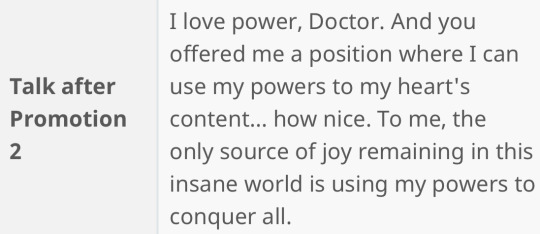
To me, the only source of joy remaining in this insane would is using my power to conquer all.
What Lappland is saying here is that fighting isn’t the only thing she enjoys, or even that it would be something she has always enjoyed: she says it is the only thing left for her. Her family, her friends, her home, nothing but dust now. The only thing left for her is her blades and her enemy.
Everything that Lappland knew was taken from her, and likely left her a shell of whoever she used to be, but there is one person we know for sure had connections to Lappland in the past. That person, of course, being Texas.
What’s important to note about Texas here is that her backstory is, for all intents and purposes, very similar to Lappland. Both grew up as part of the Siracusan mafia, both are sole survivors of their family, and both got out, one way or another. Their E2 art and tokens mirror each other, if that wasn’t enough to convince you that they’re narrative foils. (I can’t show the E2 art without hitting the image limit, but the resemblance should be somewhat obvious.)

I think the tokens symbolize the difference between the two pretty well: Texas keeps her family’s scutcheon, damaged but intact. She bears the scars of her past life but still has sight of herself. Lappland, on the other hand, does not have her family’s scutcheon. Having lost sight of who she once was, she is now defined by bloodshed and vengeance.
Texas has friends. She found her new family. She has people who like her, who want her around, and she has purpose. She is happy now. To Lappland, Texas’ very existence is a mockery to her. How come she gets to be happy while Lappland still has to suffer after everything? How come she has a new family? How come she has a purpose? Likewise, to Texas, Lappland represents the specter of what she had to grow past, and what she could be dragged back to if she let it.
It’s no secret Lappland has something of an obsession with Texas, but I don’t believe it to be that of wanting to rekindle an old relationship.


Lappland sees Texas as an enemy, and as her file said, she develops an obsession with those she considers enemies. But Lappland doesn’t want to kill Texas, or else she would have probably tried to kill her already. Lappland wants to drag Texas down to her level, to make her as miserable as she is. And, as she says in Code of Brawl, she wants to rile Texas up. Killing people Texas let live and bringing her their mutilated corpses isn’t a gift, it’s a provocation. Lappland wants to fight Texas, but she doesn’t want to kill her. As gruesome as it is, I think Lappland wants Texas to kill her, so she can die doing the one thing that still matters to her, looking, at least, at the face of someone she knows, instead of a cold, sterile hospital as she wastes away from Oripathy. Even in death, Lappland doesn’t want to be lonely.
#arknights#lappland#texas#long post#hopefully it’s not too rambling#my campaign to get people to appreciate Lappland continues#please just give us a Siracusa event I'm on my hands and knees here#maybe I should have split this into separate posts#not sure how many people are gonna read all this#oh well
74 notes
·
View notes
Text
BNHA: Kakashi dimension hops crossover (6)
Summary: Kakashi gets dumbed into the My Hero Academia universe through random plot devise.
Characters: Kakashi Hatake
Fandoms: My Hero Academia and Naruto
WARNINGS: Mentions of violence/injury
START / PREV / NEXT
As predicted, the day following the seal’s application is miserable.
His chest is tight with almost anxiety, pins and needles run up and down his arms making his skin itch, and he is increasingly lethargic. All symptoms of a chakra imbalance and to be expected when one’s normal chakra replacement rate was thrown out. The sensations would pass once his body adjusted as they had with his sharingan.
He is eating three square meals a day, doing the bare minimum when it came to exercise routines and avoiding excess chakra use. It had been literal years since he had had this much bed rest. If he were ever going to slap a chakra collecting seal on himself, this was a perfect time. Okay, so maybe he should have steadily increased the chakra drain over the course of a few weeks for a smoother adjustment period. Hindsight and all that.
What mattered was that he would be fine, and he just had to wait it out. Bright side? No one had commented on the seal yet. Oh, he has definitely noticed serval people throwing the odd confused frown at his shoulder, but that was as far as anyone had gone in acknowledging it. His oh so clever strategy of acting like nothing was wrong worked so much better when he wasn’t surrounded by other shinobi and medic-nin.
“Your blood pressure is still too high. Are you sure you haven’t been experiencing any additional fatigue or other symptoms? Is something about the hospital causing additional stress? If there is something wrong, we should work on strategies to fix the problem.”
Well… it worked on everyone who wasn’t Wada. The man was irritatingly persistent in his doctoring. Apparently, the pressure of adjusting to an increased chakra drain wasn’t doing his body any favours.
“Maybe it’s a part of my quirk. High regeneration. High blood pressure.” Kakashi shrugs loosely not bothering to look up from HEROES and HEROINES May Issue. Unlike his previous reading material, people gave him odd looks when they saw him reading these magazines which immediately upped their entertainment value 100-fold.
Wada undoes the compression sleeve he had been using to measure Kakashi’s blood pressure, lecturing as he goes, “From what I can tell your cells produce more energy-rich molecules, ATP, NADH, then is typical, increasing cellular functions. Where your cells are getting the energy to produce these molecules, I have no idea seeing as you eat about the same amount as any baseline human. What I can safely say is that it should not influence your blood pressure. If anything, your blood pressure should be a bit lower than average. Now don’t dodge the question.”
He pauses, waiting for Kakashi to cave and suddenly confess. Kakashi, an old hat at dodging medical questions, continues reading unperturbed.
“I’ve been at this for over 30 years. An attack like the one you suffered is understandably traumatic, not to mention the stress of severe amnesia. I’m sure, whatever is bothering you, I’ve heard it before.”
Kakashi very much doubts that. “I feel fine.”
Wada huffs, unconvinced, “Young men. You all think that admitting you have a problem is a sign of weakness. High blood pressure can damage your heart and lead to problems later in life so finding the cause is important.” Good thing a shinobi life spans tended to max out around 30. The odds of him making it to an age where he’d have to worry about the long-term effects of anything were pretty low. He doesn’t voice this opinion, continuing to read.
Wada continues talking with greater gusto, “No matter, I’ll prescribe you something for stress hopefully that’ll help with your blood pressure. However, this is no replacement for healthy habits both physical and mental. You should consider professional therapy.”
Kakashi snorts. Yeah, that sounds about right.
“Oh, you think that’s funny do you,” Wada makes to grab HEROES and HEROIENS and he lets the doctor pull the magazine free from his hand. It gives him a good view of the man’s irate expression.
“No, of course not.” Kakashi attempts to placate and gets a light smack over the head with said magazine for his troubles.
“There is no shame in pursuing a healthy mind!”
“Weren’t we going to test my quirk today?” He complains to derail the current line of questioning.
“I have half a mind to put it off and have you rest another week,” is threatened before Wada’s stern expression relaxes, “Lucky for you, I’ve booked you into serval tests that can’t be rescheduled.”
Kakashi breaths out dramatically. He thinks Wada might have made a good medic-nin if he had lived in Konoha. Sure, he is a little too trusting, but he was also not above pestering his patients into taking better care of themselves. Sakura would approve.
The doctor, with the assistance of an attending nurse he hadn’t bothered to learn the name of, helps Kakashi out of his bed and into a wheelchair, ignoring his protests about his leg being all but healed.
“You’re to avoid putting weight on it until you start physical therapy,” Wada snaps at his continued complaints, “You’ll need to be careful, extended bed rest and surgery can leave your muscles weakened. Also, leave that magazine behind. You’re doing eye tests when do you think you’ll have time to read!”
Kakashi doesn’t push the matter further, resigning himself to being wheeled down the hospital halls like the invalid he was pretending to be. It is not like Wada knew about his frequent excursions to the roof or the fact that he has been running through strengthening exercises on his own time for several weeks now. Best he keeps that information to himself.
Partway down the hall, he pulls out HEROES and HEROIENS from where he had slipped it into his shirt, enjoying Wada’s exasperated expression. Of course, he stops reading when the doctor threatens to start lecturing again. The man could definitely talk when given the chance.
Wada and the nurse take wheel him to a set of double-door elevators which take them down several floors below the ground level. The hallway they exit of a mirror of every other hospital hallway. Grey and white walls, pale blue lino floor and bright fluorescent overhead lights. The only difference is that this hallway is lined with heavy-looking metal doors. From snooping through patient files, he knows that all quirk tests are carried out in specially designated underground ‘safety rooms.’ That doesn't make him any more thrilled about being several stories underground. It cut down on his escape roots.
“These are some of the more secure recovery wards in the hospital,” Wada explains as their little group stops at a small reception desk where the doctor taps away at a computer screen, “they’re mostly for treating patients with unstable quirks.” Kakashi maintains a neutral expression, accepting the explanation.
Wada wheels him up to a steel door, swiping his ID card which also doubled as a key to many areas of the hospital. The heavy door is automated and slides open. A lot of the doors in the hospital operate this way and always made sneaking around slightly more troublesome.
Inside walls and floor are plain white and there is an odd number of tables and chairs pushed to one side out of the way. Everything stinks of disinfectant. On the far wall is a single solitary painting of a tree in a field, the only splash of colour in an otherwise depressingly sparse room. A poor attempt at living up the space. The opposite wall sports a rectangular, reflective surface which was probably some sort of observation booth. Well, if being underground hadn’t put him on edge, this obvious confinement room definitely did the job. Kakashi eyes the space. Worse comes to worst, he could use the kamui and remove the adjoining hallway wall then climb his way out through the elevator shaft. There are only two other people in the room with him and one woman at the reception desk, all were most likely unenhanced with quirks unsuited to combat, easily removed. He doesn’t let his body language reflect his unease. He is just a little on edge because the new seal is messing with his body’s natural homeostasis. If this is a trap there would have been other signs of deception before now.
“Yes, I know it might seem like a whole lot of fuss just to run through a few flashcards,” Wada comments, oblivious to Kakashi’s poor mood. He waves to his assisting nurse who wheels over and lowers one of the metallic tables so Kakashi doesn’t have to move from his wheelchair. “But it’s a standard safety procedure when an unknown quirk is involved. Trust me, this is a lot easier than travelling to an external testing range.”
Wada stops to give Kakashi a once over, frowning, “How much do you know about your quirk sub-type?”
Kakashi shrugs, “Nothing much.”
“Ah,” The doctor’s frown grows, and he grimaces, “Of course you don’t.” A sigh.
“Typically, ocular quirks will act to enhanced sight in some way or improve base level memorisation and recall ability. It is also common to have a replicating function, allowing the user to produce some sort of copy of things they see. In rarer cases, ocular quirks result in precognitive abilities.” Wada explanation falters, “They can also have a line-of-sight emitter effect, such as laser vision, optical blasts, a few instances of mind control and other mental effects. These can also be incredibly dangerous if the user isn’t in control. There have even been instances where whole buildings have been levelled.”
“I see.” He supposes Wada's irritation at this private 'quirk' testing made a bit more sense. A doctor faced with an unknown and possibly dangerous ability would be annoyed if said patient went about experimenting without taking safety precautions.
“I should have checked whether you knew the dangers instead of just assuming. Apologies. That is my own error.”
He peers at Kakashi, almost guilty now, “and you don’t have a phone either so there would have been no way for you to research quirks yourself.”
“Ah,” Kakashi rubs the back of his head not likening how torn up the other man seems to be seeing as Kakashi had ever been in any real danger. ��Don’t worry about it,” he reassures.
His reassurances land flat, the doctor still frowning, “I’ll see if I can get you access to the internet somehow.”
Privately, Kakashi adds 'research' to the list of functions ‘phones’ apparently provided and 'internet' to his growing list of terms to investigate.
Wada sighs again. “Regardless, let’s get these tests done first.” He places a thick folder labelled National Standard for Registration: Kit Type 3 alongside one of those portable keyboard-less computers the doctors tended to carry around. “Hold on, been a while since I’ve done one of these. Need to find the rights files. Ah, here we go. First, these rooms are monitored, and all tests are recorded. The data collected is confidential, accessible only to the patient and physician unless doing so causes the patent harm. Information regarding quirk function and use is shared with the Registry Office. You have a right to stop testing at any point. You got that?”
Kakashi grunts, his already poor mood souring further. He is not sure he wants the hospital - or anyone - keeping records of anything sharingan related.
“I’ll take that as a yes,” Wada continues unperturbed, a testament to his serval weeks of trying to doctor Kakashi, “remember to let me know if you’re experiencing any discomfort. Don’t want you busting anymore blood vessels.
Kakashi lets out a tired breath, “Sure.” The sooner they left this room the better.
“We’ll test memory and vision first to compare to your baseline, then we’ll run through the replication and precognitive tests just in case.”
The nurse, who had been on the opposite side of the room waves, “All ready over here.” There is now a large poster with letters of varying sizes hung on the wall. He recognises the chart from his previous eye tests.
“Okay, let’s start with just uncovering it. Make sure you’re looking away from me as a precaution.”
Kakashi resists rolling his non- sharingan eye at the obvious instruction, shifting his attention to the poster on the wall. He flips his padded eyepatch up with his index finger so it partially rests on his forehead. All the letters, no matter the size, immediately snap into sharp focus. Nothing spontaneously combusts under his gaze. When he glances at the painting of the tree, he can now see a lack of brush texture, suggesting that it wasn’t a painting but a print of some sort. With that useless information now forever etched into his memory, he turns back to examine at Wada.
The sharingan picks out all the wrinkles and pores lining the older face. It focuses in on minuscule muscle movements as the man’s expression shifts from professional and accommodating to curious. The doctor’s fingers twitch ever so slightly over his computer. Most likely an unconscious habit. The man’s breath is slightly uneven like his chest can’t smoothly expand, suggesting some sort of lung problem. A past smoking habit perhaps? Nothing threatening is revealed.
“Doctor.” Kakashi prompts when Wada spends a little too long staring back at him. The sharingun did have a weak hypnotic effect, encouraging extended eye contact to help catch targets in genjutsu. Kakashi rarely uncovered his eye in the presence of civilians so he doesn’t know if the effect is more pronounced or if Wada is just curious.
Wada blinks, “Well…I certainly see where the ‘wheel’ description comes from.” He spends a second more staring then turns to start writing notes and tapping away at his computer screen. “I wonder if those spinning tomoe are purely cosmetic or if they have some other function because they are certainly fascinating to look at. There is also faint bioluminescence to the eye which is a common feature of ocular quirks…”
Honestly, the blatant eye contact is weird. Even his closest allies tended to avoid looking at his sharingan out of habit - expect for Naruto who was an outlier in almost everything - for understandable reasons. He thinks the people here would also exercise caution if an ocular abilities included mind control or exploding a person through eye contact. But no, Wada just goes right ahead and stares. A few seconds later and the unnamed nurse is also looking curiously at his eye.
…
…
Aside from redoing a standard eye exam, Kakashi runs through a marathon of flashcards to test both his memory and then precognitive abilities. The tests are done with lights on then in the dark and Kakashi is given a perfect 20/20 and an enhancement score of ‘15 grades above average’ for both. There are also several pages worth of words and numbers in progressively complex arrangements to test his information retention. Of course, everything is easily remembered with the sharingun active.
“Well, it seems to give general across the board vision enhancement alongside perfect recall and retention,” Wada finally concludes as he records all Kakashi’s results, “Of course, we’ll have to re-test retention in a few days so see if the information degrades over an extended period and we don’t know whether your quirk effects your long distance eyesight, but, for now, this appears to be all. The link between your quirked eye and the regenerative side-effect is still unknown. Odd that we couldn’t trigger any ‘copy’ function considering the quirks name though ‘copy’ could also be a reference to memorisation. If any other features do reveal themselves make sure you alert a medical professional.”
…
…
Kakashi despises the process of getting an MRI with a heated passion. He hates having to lie prone in a loud confined space. It is the height of discomfort, making him tense up and clench his jaw. It is only the fact that Kakashi had researched and mentally prepared himself for the experience that stops him from accidentally snapping someone’s neck.
“We’ll have the results back in a few days,” Wada informs once the trying ordeal is over with, “From there we’ll update the Registry so you’re properly in the system. Speaking of which, have you made any progress on remembering a surname? I need something for the forms.”
“Hatake,” he grunts, too irritated to bother evading - he just wants to return to his room and wait out the side effects of his seal in peace- the question like he had every other time the man asked, “I think I prefer Kakashi though.”
It wasn’t like the name meant anything here and, who knows, maybe someone would come looking for him. This way they would have a trail to follow.
NEXT
#bnha#bnha fanfic#naruto#boku no academia#CrossOver#kakshi hatake#dimension travel AU#fanfiction#my hero academia#more hospital stuff#probably a bunch of medical inaccuracies#quirk biology#quirk stuff#world building
40 notes
·
View notes
Text
Hellsing Liveblog, Ch.11-13

This is the “Balance of Power” arc.

One of the things that frustrated me about the Hellsing TV anime (as opposed to the Hellsing Ultimate version) was that the TV series aired while the manga was still running, and it seemed to struggle between following the source material or just diverging into all new stories. I think if Gonzo had made up their minds one way or the other, it would have ended up a better show. Instead, there were all these filler scenes of Seras training with human soldiers, which seemed like an utter waste of the character’s time. Worse, this meant the human soldiers featured much more prominently than they ever did in the manga, where they all get killed off by Chapter 9 or something. And if you know that’s coming, like I did, it makes the human soldiers that much more insufferable, because you know dorks like Farguson aren’t going to matter, but they get tons of screen time anyway. Farguson is like every episode of Dragon Ball GT condensed into a single character.
Here, in the original manga, it’s pretty clear that the soldiers never mattered, because the only time you ever see them is when Jan Valentines’ ghoul army slaughters them all. They only existed so Integra would have something to be in charge of, but the only ones who actually matter here are herself, Alucard, Seras, and Walter. In this chapter, Walter practically admits as much, when he states that there were 96 staff members, and now we’re down to ten: Walter, Integra, and eight jabrones who weren’t at the base that day. Well, maybe those eight guys will show up later and do something important? Bullshit they will, they never get mentioned again. The Gonzoverse might have been able to break some new ground by focusing on those human characters more, but what they actually did was half-assed, and it looks all the more futile when you know how unimportant they are to the original work. Walter just hires a band of mercenaries to backfill all the vacant positions, and I’ll give you three guesses what happens to those guys.

Concerning “Millennium”, their mysterious new enemy, no one has any idea what they are. A bunch of people try to research it, because we didn’t have Google in 1999, or at least not Google as we now know it, so if you wanted to know something cryptic you just had to rummage through a card catalog in a library or whatever. But Integra just makes the logical leap that “Millennium” is a reference to the “Thousand Year Reich” dreamed of by Nazi Germany. This seems like a stretch, but I think Integra’s reasoning is that this is the only “Millennium” reference that could possibly be worth Hellsing’s attention.

Later, Integra meets the Wild Geese, the merc group Walter hired, and explains their assignment even referencing the Bram Stoker novel. So I guess Dracula is a real book in the Hellsing world, but it must be at least partially based on a true story, right? The Geese don’t buy any of this, so Integra introduces them to Seras to prove that vampires are real.

They all laugh at Seras until she starts flicking their leader, Pip Bernadotte, with her fingers. Then Alucard shows up, and that seems to be enough to convince them.

After this, Integra gets a letter from the Iscariot Organization, inviting her to a meeting with Enrico Maxwell at the Imperial War Museum. The whole thing introduces Bishop Maxwell very effectively. He tries to play this off as a peaceful, diplomatic conference, but he makes Integra wait, and she’s still sore about Anderson’s violation of their treaty back in Chapter 5-6. Maxwell takes all this in stride, then replies that he could care less about the deaths of even two billion Protestants, so the two guys Anderson killed mean nothing to him. He’s only here because the Pope ordered him to do this, and he calls Integra a “Protestant sow” for good measure.
At this, Alucard comes out to stand up for Integra’s honor, and then Maxwell responds by bringing out Anderson, except Anderson has a berzerker rage thing going, so it kind of ruins Maxwell’s posturing. For all his contempt, he really was ordered to London to talk to Integra, so he’d probably get in trouble with the Pope if Anderson starts a big superhero battle in a museum.
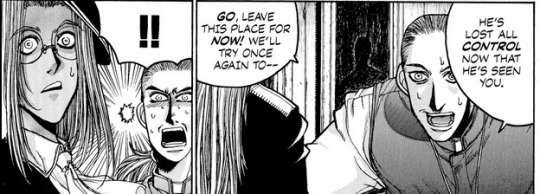
In Cross Fire, the unpublished manga that was sort of a precursor to Hellsing, Maxwell looked a lot like Sir Integra does now, so when Kouta Hirano brought him back for this arc, he slicked his hair back and removed his glasses. On the other hand, Integra doesn’t look much like the early Integra anymore either. By now, Hirano seems to have settled on her design, straightening her hair out and making her face longer and thinner. Anyway, Maxwell’s brinkmanship has backfired, and now even he can’t stop Anderson, so what can be done?

Luckily, Seras is here to provide a distraction, as she leads a tour group of elderly Japanese tourists through the gallery. For some reason this kills Anderson’s fighting mood completely, so he leaves. Alucard also leaves, because he hates being up during the day. Walter gives Seras a hearty thumbs up for defusing this tense situation. Good job, Seras. You’re doing amazing, sweetie.

All right, so what’s so blamed important that the Pope would send Maxwell to London? Well, he knows about Millennium’s attack on Hellsing’s base, and he has some juicy deets on them. After making Integra say “please”, he explains that “Millennium” was a Nazi military unit responsible for transferring resources and personnel for Nazi Germany. They relocated a ton of these resources and personnel to South America for safe keeping. Integra’s not too impressed with that, since “Nazis fleeing to South America after the war” isn’t exactly a shocking revelation.
The twist here, though, is that Millennium was smuggling Nazi stuff to South America during World War II.
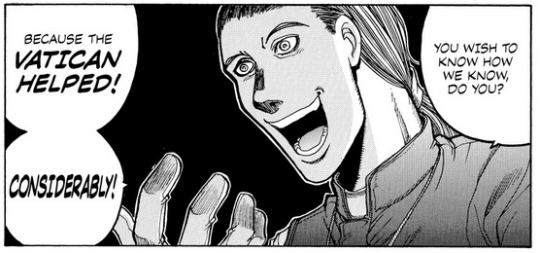
Also, the Vatican helped Millennium do this? I never understood this part of the story, but I think it gets explained later. I mean, it explains how Maxwell would have this lead to share with Hellsing, but it raises more questions than answers.
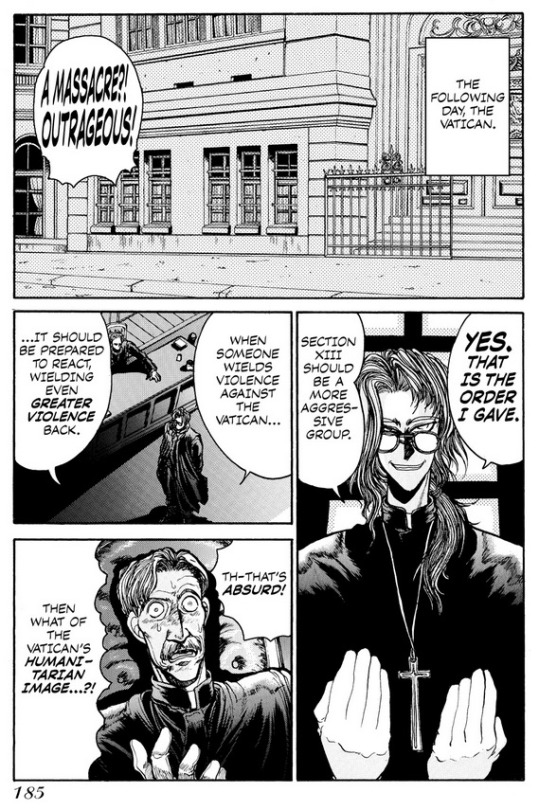

Volume 2 ends with another chapter of Cross Fire, starring Heinkel Wolfe and Yumiko Takagi. In the first story, they saved hostages from Islamic terrorists. This one is them recovering stolen church money from radical communists, which I guess could have been a thing in 1998? It’s basically the same story, though, as they send Yumiko to infiltrate the bad guys, then they slaughter everyone in sight. Mostly, I want to focus on the part at the end, where Maxwell, the leader of Iscariot, justifies the use of extreme hyper-violence in the name of the Catholic Church. You sort of get the sense that the Iscariot Organization in Cross Fire was a concept in search of a villain. the idea of two girl-assassins dressed as a nun and a priest might have had some traction, but Hirano really seems to have had trouble coming up with worthy enemies for them to fight. But Hellsing brings vampires into the mix, which suits the Iscariots quite nicely.

Back to “Balance of Power”, the third part features Seras training with the Wild Geese in the middle of the night. For some reason, Seras expects them to shoot targets from over 4km away. She can do it, but only thanks to the vampiric senses Alucard showed her how to use. It’s like she doesn’t realize that this is an ability she only has because she’s a vampire or something.

Indoors, Alucard and Walter discuss the whole Nazi angle. Al isn’t terribly surprised, because he only knows three who have ever used undead warriors for combat.
1) Hellsing
2) Himself
3) The Nazis.
He knows #3 is legit, because he and Walter destroyed a Nazi research facility during the war. Supposedly that contained all their work on the undead, but now that we know Millennium was smuggling important stuff from Nazi Germany to South America, it only makes sense that they’re the ones who devised the Valentines’ ghoul attack. The bigger point of this scene is to reinforce that Walter used to be a big wheel in Hellsing, teaming up with Alucard to have Golden Age WWII adventures. And now, Hellsing will be sending Alucard and Seras to South America to investigate this new threat.
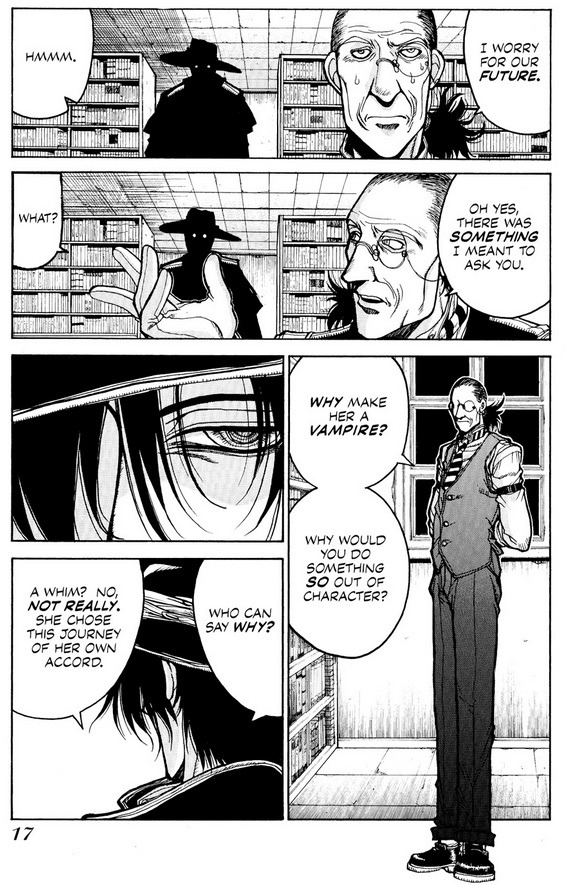
Here, Walter asks the big question: Why make Seras a vampire? I’ll have more to say about this later, but I dig this scene because it works as an exposition scene, but there’s more to it than that. Alucard’s only apparent motivations are over-the-top violence and doing his master’s bidding. Helping Seras doesn’t seem to fit either of those, so it does indeed feel out-of-character. You’d expect someone to ask this question, and by now there’s really only two people left who know Alucard well: Walter and Integra. So yeah, let’s have Walter ask the question. But later on, it becomes clear that the point is not the question itself, but the fact that Walter is the one asking it.
For what it’s worth, Alucard doesn’t seem to know, or maybe he just doesn’t want to spell it out. He keeps saying that it was her “choice”, except he had to make his own choice that night. He could have just let her die, regardless of any requests she might have made. Al remarks on her tremendous resilience on that night, since she was surrounded by death and hopelessness, but didn’t resign to her fate. That impresses him, so I guess we can say that he chose her because he found her to be such an impressive specimen, in spite of some of her goofier behavior. As it currently stands, Seras can’t even travel across rivers or oceans, a weakness for lesser vampires, but not a problem for Alucard himself. He seems to think that’ll all be resolved once she finally drinks blood, and he expects that it’ll just be a matter of time before she does. Ominous!
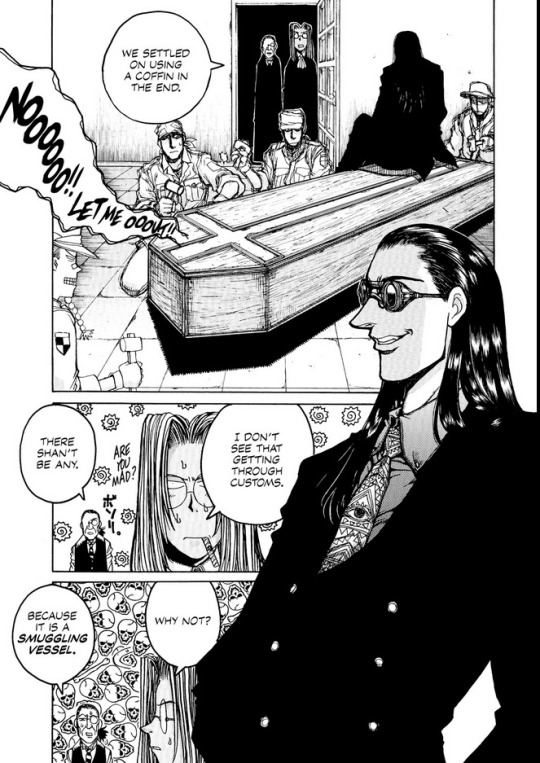
As far as transporting Seras to South America, Alucard figures the easiest thing to do is nail her shut in her own coffin. The Wild Geese know a smuggling operation that can fly them to Brazil without any messy customs. That works out, since they also have to transport Alucard’s coffin, and all the guns.
Integra asks why Alucard is dressed like this, and he says he can’t wear his usual stuff because he’d be too obvious to their enemies. Also, he doesn’t need to spend the whole trip in his coffin, because sunlight and traveling over water doesn’t bother him, I guess? I don’t really get the water thing. If Seras can’t travel over running water, what difference does it make if she’s in her coffin or not? I can accept that Alucard, who’s basically a super-vampire, would be immune to the whole water thing, but it becomes a plot point later on, so... aw, forget it

Integra gives Alucard only one order: Search and Destroy, which seems kind of vague when you think about it. Anyway, she’ll be saying this about a hundred times before the story is over, so we may as well appreciate the original.
#2021hellsingliveblog#hellsing#alucard#sir integra hellsing#walter c dornez#seras victoria#enrico maxwell#pip bernadotte#did i forget anyone?#nah i guess that's it
21 notes
·
View notes
Photo
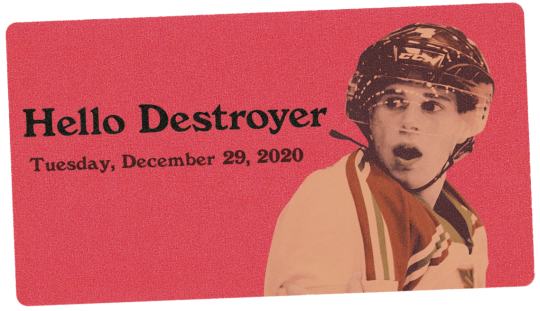
For today's feature film, we look at Kevan Funk’s critically-acclaimed debut feature Hello Destroyer. The film swept Vancouver Film Critics’ Circle, winning 5 awards including Best Canadian Picture, Best BC Film, and Best Director. I've compiled a bunch of reviews and filmmaker interviews on the institutionalized violence, hockey culture, the craft of filmmaking and the Todd Bertuzzi case.
Synopsis
A young junior hockey player Tyson Burr’s life is shattered when a routine hockey play goes bad. In an instant his life is abruptly turned upside down; torn from the fraternity of the team and the coinciding position of prominence, he is cast as a pariah and ostracized from the community. As he struggles with the repercussions of the event, desperate to find a means of reconciliation and a sense of identity, his personal journey ends up illuminating troubling systemic issues around violence.
Where to Stream
CBC Gem if you are in Canada
Keep Reading for
Directors Guild of Canada post screening Q&A: does the Todd Bertuzzi case inspired the film?
Aggressively Canadian: An interview with the director Kevan Funk
Hello Destroyer explores the thin line between hockey menace and model
Review from Josh Cabrita of VIFF
More filmmaker Q&As
Content Warning: Violence
🎤 DGC Post screening Q&A
Audience: I grew up in BC. I remember in high school, the Todd Bertuzzi case was hung over the news of the city for a while. And I was just wondering if that's something that inspired this film at all?
Funk: Yeah. Todd Bertuzzi is my favourite hockey player of all time. So, yes definitely. I grew up in Banff, but I was a Canucks fan. The Todd Bertuzzi thing was something that I found remarkably frustrating at the time because I remember it really well too. I remember the hit on Steve Moore ahead of time when he hit Naslund, and I remember very well there was this intense bloodlust in Vancouver for retribution. And I don't mean just like among the fans. (There were) literally editorials about being like "we get pushed around too much, we need some identity. You can't let this happen, blah blah blah." And Todd was that guy. I still think Todd certainly deserves to be held responsible for what happened as an individual in that incident. But again, like that moment in terms of thinking about cultural culpability and how the idea of an act of violence extends beyond just a perpetrator of a crime and the victim and how a much broader group of people are implicated. I'm I really don't believe this idea of good and evil is something that really exists. There's like a select handful of people who we might be able to define as evil. But I think most violence that exists has a lot to do with social or cultural conditions around the people who are involved in that.
The Todd Bertuzzi thing was definitely something that informed it. I was hesitant to talk about it earlier before the film sort of got its own life and took out its own legs because I didn't want it to be "the Todd Bertuzzi story" because it informed it. But so did Derek Boogaard, Rick Rypien, a lot of these guys. And to be honest, the fundamental thing that started me on writing this film was Errol Morris's film Standard Operating Procedure. It's about the prison guards at Abu Ghraib who were busted for this despicable torture. He does this incredible thing of holding them morally responsible for what they did, but also showing that they're victims of a system that essentially asked them to do this and then throw them all under the bus to wipe its hands clean when it becomes public. So that came first. But certainly heavily informed by Todd Bertuzzi. I mean, his name is Tyson Burr. You know, there're some strong hockey knots in there.
🎤 Aggressively Canadian: An interview with the director Kevan Funk
NOTEBOOK: You’re a Canadian filmmaker making a film with hockey in it, so there’s an impression that the film is about hockey. But from watching the film there’s a sense that it’s not the game, necessarily, that interests you, that if you were working in a different setting, you’d have made the same film, but about, say, football or the military instead of hockey. Would you say that that’s an accurate assessment?
KEVAN FUNK: Yes. The inclusion of hockey has much more to do with its presence as a cultural institution, because the film is very much about institutionalized violence. I have this frustration with English[-language] Canadian cinema’s lack of boldness in terms of embracing our identity and placing ourselves in Canada. So I knew I wanted to make something that was very Canadian, and so hockey just sort of ended up being that.
Hockey movies are super interesting in that they’re associated with being very Canadian, but most of them—the majority of them—are goofy comedies that say very little about either Canada or the sport of hockey itself. So again, even though Hello Destroyer wasn’t a film about hockey per se—certainly more the setting than the subject, having that locker room culture be reflective of an actual reality was very important to me, because I don't think that it’s represented properly in most work.
📄 Seventh Row: Hello Destroyer explores the thin line between hockey menace and model
In major junior hockey, players must walk a thin line between what their coaches deem acceptable and unacceptable violence. If players avoid violence, they risk being seen as “soft” by their teammates and employers. At a home game when the team is trailing, the coach, Dale Milbury (a name referencing two notorious champions of hockey violence, Dale Hunter and Mike Milbury), demands that the team “protect the house”. Eager to prove his worth, Tyson throws an illegal check that slams an opposing player face-first into the boards, leaving his opponent with broken vertebrae and a brain hemorrhage.
Televised hockey tends to glorify cheering for violence but provides no explicit reminder of any physical consequences. Hello Destroyer breaks this convention and does not sanitise the violence. In Funk’s hands, a fight is not heroic, gladiatorial combat, but sweaty, desperate grappling, conveyed through the thudding of fists, cries of pain, and, loudest of all, the cheering crowd. Funk frames the fights themselves in claustrophobic close-ups, frequently shifting focus, and never quite providing a clear view as the punches connect. The effect is alienating, and it forces an audience familiar with hockey fights to confront their brutality. Funk implicates fans for enabling violence by foregrounding the pleasure on their faces and the players’ pain through the physical ugliness of the fight.
✏️ Review from Josh Cabrita of VIFF
Kevan Funk’s debut feature, Hello Destroyer, is not only a perceptive exegesis of Canada’s colonial history and cinematic representations of hockey, but also about a myth that all children who play the game grow up with. Funk has stated in interviews that if the film was made in another country, it might’ve been set in the military or a different institution, but the fact that Hello Destroyer -- one of very few Canadian films to grapple with the sport’s hypocrisy -- takes place in the world of junior hockey makes it hard to deny the specifics for the allegory. The buzzing sounds of the overhead lights in a vacant rink, the dress code of having a black suit and tie for every game, the anger expelled at a hockey stick during a coach’s rant: these are all textures and details I’m firmly acquainted with. Yet it’s these same environmental observations that form the basis for a critique of hockey culture's contradictions and hypocrisy: contemplation and belligerence, civility and violence, alienation and ‘community’.
But, above all else, this is a film about culpability: the role complacency, the status quo and generational exchanges play in redirecting guilt to maintain a corrupt system of power. Tyson may not be the main perpetrator against the opposing team’s player (for guilt requires free will - something the film posits is out of his hands), but he’s most certainly guilty of contributing to a culture that normalizes the root causes of such an action: how he willingly shaves his own head after his teammates buzz it in a ritualistic hazing, how he remains silent when a lawyer fills in his voice, and how he stands by as a teammate is awarded the player of the game and parades a traditional indigenous headdress around the dressing room.
🎤 VIFF Post screening Q&A
19 notes
·
View notes
Text
“Taking it on the Chin”: or why words matter even more in the time of the corona.
Words matter. Every writer knows that. Politicians know it too. Words are how we communicate ideas, or sometimes fail to communicate them. Sometimes that failure is deliberate. But for politicians, as well as writers, it is rarely accidental. When Boris Johnson uses a word so obscure that most of his audience doesn’t know what it means, or lapses into Ancient Greek, or when he pretends to stammer and stumble for comic effect, he’s giving us the on equivalent of Donald Trump making the “loser” sign while pretending to scratch his nose. He’s using words as a smokescreen on which to project the message: I’m cleverer than you are. That’s why I can get away with never giving you the truth.
Four weeks ago, Covid-19 was still news. Whenever it trended on Twitter, it always seemed to be spelt wrong. Coronoavirus: corvid19; the country seemed to be struggling with the words as well as the concept. And when Boris Johnson suggested in interview that maybe taking it on the chin would be the best way to deal with the crisis, his supporters were quick to believe that his words had been misconstrued. It’s only a figure of speech, they said. Words don’t really matter.
But yes, they do, and here’s why. Words do a lot more than communicate. They help create an mindset. And during the past four weeks or so, the government has been building a mindset of conflict, of aggression, of supremacy, of war. The daily Cabinet meetings have been reframed as The War Cabinet. The daily reports on the Prime Minister’s health have contained a repeated narrative that “he is a warrior”, “he is a fighter”, “he is the strongest person.” Now that he is recovering, they promise he will be “fighting fit” in no time. And yes, these are all figures of speech, but it’s a disturbingly unified kind of imagery. It’s the imagery of combat, of “taking the virus on the chin.” And it’s full of hidden messages, all as toxic at the first one.
Taking it on the chin is a boxing image. A fighter learns to take the hit. Only losers and cowards don’t. Losers and cowards walk away, but fighters take it like a man.
And no, it’s no surprise that our self-styled War Cabinet, as well as those who have consistently used this aggressive, warlike language, are all men. The women who have spoken out so eloquently against it – Marina Hyde, Emily Maitlis - have mostly been shouted down. In war, says the current narrative, women are expected to stay at home, manage, make do and support morale. They’re not expected to ask questions, or point out mistakes, or make comments. Even the Queen channelled Vera Lynn in her address to the nation.
Except that we are not at war. We are in a global pandemic. And in this pandemic, women are at risk, not just from the virus, but from this very male-dominated narrative. Women are losing access to cervical and breast cancer screenings, maternity and abortion services, as “non-essential” services shut down. And they are increasingly at risk from domestic abuse, which has shot sky-high during this time of lockdown, and which feeds on aggressive narratives. It is no surprise to lean that domestic abuse skyrockets around important sports’ events. And a narrative that says “we’re at war” makes violence inevitable. During wartime, certain groups - the elderly, the disabled, the poor – are often seen as inevitable casualties. Some regimes – ours included – might even consider it objectively beneficial, when it comes to boosting the economy, to lose half a million people. It’s a message we’ve heard a number of times, lurking behind “herd immunity”. After all, they keep telling us, the poor and the old and disabled are a drag on our benefits system; a drag on our “weakened” NHS. As if the NHS itself had failed to take it on the chin. And let’s not forget that, however much clapping for carers our Government now encourages, it is the same Government that applauded the decision not to award them a pay rise just last year. To them, nurses and carers count as “low-skilled workers.” Low-skilled workers may earn applause, but that doesn’t stop them from being expendable.
Which all goes to say, that this wartime narrative is very convenient for a certain type of politician. It gives them the chance to shout down dissenting voices as disloyal or unpatriotic. It allows them to send out the message that people only die of this virus because they are weak, or cowardly, or just not British enough to survive. It allows them to voice a renewed distrust of foreigners – as if we didn’t have enough of that in this country already. And it allows them to think of the victims of coronavirus as some kind of inevitable consequence of war, while painting themselves as heroes for “battling the enemy.”
Except they’re not. Because, here’s the thing. There is no fucking enemy. A virus doesn’t care about morale, or politics. A virus doesn’t respect borders, or care whether you’re brave or not. A virus really doesn’t care whether you take it on the chin. Nor do the families and friends of the thousands of people who have died so far of a virus that shows no real sign of slowing down, thanks to this Government’s mindset.
“But... it’s a figure of speech”, they say. “People have always used this language when it comes to battling illness!”
Actually, they haven’t. People have been complaining for years about the language of illness. Cancer sufferers, especially, have been vocal in their resentment of a narrative that frames death as a “defeat” – basically, a failure to take cancer on the chin. We can do better, and we should. In this time of global crisis, words matter more than ever. We need to ditch the War Cabinet and look to the medical cabinet. The language surrounding this virus should not be the language of blame, or bluster, or individualism, or patriotism, or macho posturing, but the language of intelligence, of problem-solving, of co-operation, of globalism, and of compassion.
You don’t need your boxing gloves for this challenge, boys: you need to put on your thinking-caps.
Or didn’t you have them at Eton?
156 notes
·
View notes
Note
Tell us about the Murderbot ttrpg!! 👀👀👀
ahh thank you for the interest!!
it’s basically a project that spun out because i love tabletop rpgs and game design, and i love murderbot, and i also noticed that the Forged in the Dark system would work super well for the Murderbot Diaries
there are entire sections of the novels that I could write out with the game mechanics! like, the start of rescuing Mensah in Exit Strategy is clearly an Engagement Roll with a Social plan that resulted in a Desperate starting Position when the GreyCris rep immediately caught wise to the fishiness and drew a stun gun; and of course anytime Murderbot forces itself to talk to a human it’s expending Stress to push itself for an extra die (greater chance of success in an action it likely has no dice in) on its roll, etc etc. Hell, flashbacks and the stress mechanic just seem made for Murderbot and the type of fiction that the Murderbot Diaries is.
and there definitely are sci-fi Forged in the Dark games out there! Scum & Villainy is a game about space scoundrels (a la Han Solo, bounty hunters, or space rebels) that might work plenty well for a Murderbot Diaries game. In fact, the whole Rogues & Rampancy OC fic setting that @iztarshi and I write in was very inspired by and designed to work with Scum & Villainy.
but still... can we make Forged in the Dark more Murderbot? I think the answer is yes. So I’ve been listening to game design advice on the Beam Saber discord and putting together concepts for playbooks and thinking about how to shake up the FitD system to create a game that makes each session feel like a chapter or so of a Murderbot book.
Under a cut for length- If you or anyone else has feedback, discussion or questions, I would gladly welcome it!
Broad strokes, I want the game to be machine intelligence focused. the playbooks are “Functions”- Security, Comfort, Combat, Research, etc. The playbook is the primary thing by which a character defines itself (there aren’t “races” [gross] in FitD, although I’m toying with the idea of including Form abilities to account for organic, metal, digital etc people having radically different access and physicality) so coming up with not just unique special abilities but evocative exp triggers and useful special items is important. Here’s some examples of special abilities, names and phrasing tbd:
When You Need Me: [Security] Those who trust you know you’ll be there when you're needed most. Two times per mission, you can arrive on a scene where an ally needs you without paying flashback stress costs. How do timing, planning, chance and opportunity align to make this happen?
The Weak Point: [Playbook tbd, probably Research] You know what the weak point of every tool and system is: the dumb end user who operates it. When you exploit end-user vulnerability, you do so with increased effect. When you gather information by taking advantage of a tool or system's end users, take +1d.
How Bad Could It Be: [Human] When you act ill-advisedly and endanger yourself, mark playbook XP.
I laugh to myself about that last move a lot.
I have a lot of thoughts about how the Security playbook probably resembles an unholy mixture of Blades in the Dark’s Spider, Beam Saber’s Soldier, and the Sprawl’s Hacker, whereas the Combat playbook is just straightforwardly the Soldier. The Research playbook is definitely for ART- it’s information-gathering and data-crunching in both the scientific and the espionage sense, so it’ll touch on both the Hacker and Beam Saber’s Infiltrator. For the Human playbook, I’m touching on Monster of the Week’s the Mundane, and in general I’m experimenting with the idea of putting PbtA-style moves in special abilities, to mixed effect so far, I think. Otherwise, the Human playbook is mostly about getting and giving exp, and taking on more GM-side duties like world-building and thematic direction.
And unlike other games, the strength of playbooks is how easy it is to ‘multiclass’- you can pick any of a selection of abilities when you advance your playbook, including from other playbooks through Veteran advances, resulting in some unique and character-rich combinations.
I’m still having some trouble with how to change the action ratings and attributes to imitate the kinds of verbs that Murderbot and the people it deals with are use. (I think the attributes should be broadly separated into Physical, Social, and Feed, but I’m still unsure what to call them- for reference, Blades uses Prowess (physical), Resolve (social), and Insight (mental)). This system differs from mainstream TRPGs in that instead of skills or stats, you have action ratings, which broadly represent how you’re characterizing your approach to a challenge.
Here’s what Scum & Villainy’s action ratings and attributes look like:

And according to some game design theorists that i've been following, the Verbs- what a character is inclined to do and what the action rating is named for- is one of the most defining parts of what that character/what the game is like, so getting these action ratings nailed down will do a lot to characterize a Murderbot Diaries-like game.
Here’s what I have for the unnamed Physical attribute:
Assail: Subdue opposition with violence. Put your body in the line of fire and see whose parts give out first.
Maneuver: Scramble for positioning with agility or evasion. Get to the right place at the right time.
Operate: Handle inanimate objects with technical precision or bodily coordination. Manipulate a physical obstacle into or out of the way.
I’m definitely struggling most with the Feed attribute’s verbs, but feel free to ask me about the action ratings in the Social attribute. I’ve decided that Banter should be an important social action rating in the Murderbot RPG, and I do not regret this decision.
that’s some of what I have so far, but it’s not even getting into all the unanswered questions that I still have to address. Like, what should I do with Crew formation- a great mechanic where the group of players is characterized with its own character sheet and playbook- when the main character of the source fiction spends so much time avoiding being part of a team? (I think I have to assume that PreservationAux, the AC technologists, GoodNightLander Independent, and the crew of Perihelion are examples of crews in the text). what about factions? how extensively should I make up faction worldbuilding that will likely eventually be jossed as Ms Wells continues to write? What should I do with the score-downtime cycle that is so intrinsic to heist fiction, when the Murderbot Diaries doesn’t precisely use this cycle? And what should I replace it with if I decide to get rid of it?
Whew, that’s a lot! so you can see when I said “I don’t know where to start talking about this” I wasn’t joking, haha. thank you for reading if you got this far, and hopefully that wasn’t overwhelming!
tl;dr a Murderbot Diaries RPG would be really cool and is potentially doable, these are my thoughts and I’d love to hear what other people think.
14 notes
·
View notes
Text
Depression Misconceptions
Our abuse culture is fueled by a misunderstanding of mental health.
Online I see many people address depression joking with phrases like “serotonin machine broke”. And in serious cases use the hyper medicalised version of depression and mental illnesses in general as just a lack of a neurotransmitter. Either way, they are presenting depression as only a lack of serotonin.
Mental illness is not the same health struggle as type 1 diabetes and way more complex. Keep in mind even diabetes has other management factors than insulin. Comparing the two as the same or as competition is harmful to everyone.
Mental illness is more affected by environment and life factors than most non-psychological health conditions. Our bodies are complex and our mind cannot be separated from the rest of our body, but mental health is connected to our social-emotional state by treating it like we might a broken arm, heart defect or diabetes.
There is some truth in the idea of depression being only a “sick organ”. There are of course neurological and neurochemical aspects to be considered. The functioning of the Amygdala & Thalamus is altered and the size of the hippocampus are all affected. This was shown in many F-MRI’s, MRI studies. Chemically; Acetylcholine, Dopamine, Norepinephrine, Glutamate & GABA all play a role. Which in itself shows more complex neurobiological levels and shows overlap with PTSD and anxiety on physical and chemical levels.
There are genes linked to depression, but the idea that any depression is purely genetic or generally endogenic is not common. You may see it reported in some places, but the most common belief is that the “depression gene” does not cause depression on its own but instead predisposes you to it. Some studies suggest that possibly 40% of depression in a person may be genetic, but even that shows that 60% is environmental.
This complexity can be exacerbated as there are multiple physiological disorders and health conditions that can induce depressive symptoms due to multiple chemical imbalances and other functions. Chronic low blood pressure, CFS, diabetes, hypercalcemia, hypothyroidism, or vitamin deficiency can all mimic depression. These depressive symptoms can be better by treating the physical chronic health condition if not eliminated. Disability and chronic illness can be a trigger or layer of depressive disorders by both symptoms of the health condition and as a stressor or trauma that influences depression.
But what is key is that mental health is that layer of social, interpersonal, behavioral, environmental and systemic factors. We have to recognize all of this to understand our mental health and improve our situation.
It stops people considering all the factors that might influence the depression we may be suffering with and it’s always a layered experience.
Examples:
Ableism
Alienation brought on by capitalism
Attachment trauma
Child Abuse
Child Emotional Neglect
Classism
Community Trauma
Death of loved ones
Developmental Traumas
Disabilities & Disabilities
Domestic Violence
Environmental factors (Pollution)
Exposure to the criminal legal system
Global traumas
Homophobia
Incarceration
Intergenerational trauma
Lack of health care
Lack of housing
Lack of hobbies or creative outlets
Lack of social supports for issues like relationships or child care
Negative or toxic relationships
Misogyny
Poor Nutrition
Poverty
Our culture’s lack of emotional inelegance
Racism
Rape
The school system
Sexual Abuse
Spiritual well-being deficits
Substances Abuse Disorder
Your Job
Another common phrase is “if you can’t make a serotonin store-bought is a fine” way of addressing depression. They tend to be moderately effective, even the big headlines saying; “The drugs do work” or “antidepressants proved better than placebo”. The studies are not nearly definitive, including admitting the drugs only work moderately well. Many studies show inconclusive evidence or even show almost no evidence that antidepressants have a major curative power for depression, with high relapse rates and rates that are equal or lesser to other forms of treatment.
I’m not against them but we need to be cautious of and more informed. For example, Understand antidepressants aren’t just concentrated serotonin you aren’t taking serotonin or getting “store-bought”. Only a few psychiatric drugs are directly ingesting the neurotransmitter.
The Rates of depression have gone up in the past 25 years, not down. Our most recent numbers (2017) showed a rate of 7.1% in US adults and 1991 there was only a rate of 3.3%. If our steady increase in medications for depression were having a massive effect, we should have a decrease at least in the rates of major depressive episodes a year, if those with chronic depression were treated and the medication fixed the neurotransmitter problems there should be fewer repeat episodes. Now we can say some stigma decrease allows better treatment sure and contributes to higher rates, but the key part is a lack of systemic improved outcomes.
A rate of around 13% is shown in adolescents. A rise in extreme pressure in school, media consumption rates, climate grief and other social factors are all indicated to have effects. If social factors improve, these rates may decrease.
Those social factors show in the data:
Indigenous Americans and Alaskan Natives have higher rates of depression and other mental health groups.
Black and Hispanic populations tend to have more persistent and chronic depression.
Women and adolescent girls both have higher rates than those of the opposite sex.
Mixed-race people have the highest rates of depression among racial groups
Low socioeconomic status is a risk factor in developing depression and all mental health issues.
The hyper-medicalization of mental health is for-profit and born from the dismissal of childhood trauma and connected to misogyny and classism. The APA has had a history of connections to powerful groups and dismissing trauma for years, even going as far as to say horrific abuses like incest, being possibly beneficial or at least harmless to children. To this day they still refuse to understand developmental trauma and DTD. The DSM also tends to pathologize behaviours linked to stress in children, labelling them as oppositional defiant (ODD) instead of asking why.
Social political factors not taken into account, leaving our mental health and social support system lacking the tools to address the specific needs of Marginalised communities.
The hyper-medical model is also politically advantageous. If we do not notice that the way our model of employment, social precarity and systemic failures are causing depression and other illness, then we won’t’ fight back. If we don’t understand how our culture steeped in abuse affects our health we won’t change it. A healthier culture would help combat all mental health problems including depression.
Depression needs to be understood as not just your brain being a sick organ or an illness “just like any other”. Because the fact is it’s not. It’s extremely context-dependent and it’s interesting and complicated. Socio-political circumstance, environment, physical health, childhood and interpersonal relationships all impact our depression.
Which is good in some ways, because we can help alter some of those and important insights showing us combating oppression and our political system would help us! It shows us we have to be holistic in our approach.
If we have people who only think in the medicalised only structure it opens the door for the “sceptics”, “faith healers” and “ The Secret peddler” telling us to pray or “manifest” our depression away. Which is dangerous faith is important and we ought to be critical of pharmacological companies but we can’t throw neuropsychology out entirely and definitely can’t fall into toxic “self Help” or Goop style woo.
It’s healing to know you’re not stuck with a broken brain. But a brain that is struggling through multiple stressors and is currently not operating properly. But you can help it through therapy, behaviour changes, connecting with others, combating alienation, learning, needed medical intervention grounding skills, emotional regulation techniques and becoming embodied.
And by knowing while you can help yourself, you’re not the problem and nor is your body. The problem is also social factors and your history of stress and/or trauma. Which means your body is not fighting against you or failing you. Which is so liberating. Knowing what is and isn’t in your control.
Depression is not just a lack of serotonin or part of your brain that’s broken, it’s complex and complicated and tied in with our culture of abuse and trauma.
Citations undercut
Kirsch I (2019) Placebo Effect in the Treatment of Depression and Anxiety. Front. Psychiatry 10:407. DOI: 10.3389/fpsyt.2019.00407
Martin, Elizabeth I et al. “The neurobiology of anxiety disorders: brain imaging, genetics, and psychoneuroendocrinology.” The psychiatric clinics of North America vol. 32,3 (2009): 549-75. DOI:10.1016/j.psc.2009.05.004
Sandeep K and Rajmeet S: Role of different neurotransmitters in anxiety: a systemic review. Int J Pharm Sci Res 2017; 8(2): 411-21.doi: 10.13040/IJPSR.0975-8232.8(2).411-21.
Socioeconomic Status and Mental Illness: Tests of the Social Causation and Selection Hypotheses, “Christopher G. Hudson, Ph.D., Salem State College; American Journal of Orthopsychiatry, Vol. 75, No. 1.
12-19-17 Fact Sheet_Diversity.indd
A., Van der Kolk Bessel. The Body Keeps the Score: Brain, Mind, and Body in the Healing of Trauma. Penguin Books, 2015.
“Big New Study Confirms Antidepressants Work Better than Placebo.” NHS Choices, NHS, 22 Feb. 2018, www.nhs.uk/news/medication/big-new-study-confirms-antidepressants-work-better-placebo/.
Hari, Johann. “Is Everything You Think You Know about Depression Wrong?” The Guardian, Guardian News and Media, 7 Jan. 2018, www.theguardian.com/society/2018/jan/07/is-everything-you-think-you-know-about-depression-wrong-johann-hari-lost-connections?CMP=share_btn_tw.
Harvard Health Publishing. “What Causes Depression?” Harvard Health, Harvard University, 24 June 2019, www.health.harvard.edu/mind-and-mood/what-causes-depression.
Johnson, Adam H, and Nima Shirazi. “Citations Nedded.” Citations Nedded, 6 May 2020, https://citationsneeded.libsyn.com/episode-109-self-help-culture-and-the-rise-of-corporate-happiness-monitoring.
Levinson, Douglas F, and Walter E Nichols. “Major Depression and Genetics.” Stanford Medicine, Stanford University , med.stanford.edu/depressiongenetics/mddandgenes.html.
Lorant, V. “Socioeconomic Inequalities in Depression: A Meta-Analysis.” American Journal of Epidemiology, vol. 157, no. 2, 15, Jan. 2003, pp. 98–112., doi:10.1093/aje/kwf182.
“Major Depression.” National Institute of Mental Health, U.S. Department of Health and Human Services, Feb. 2019, www.nimh.nih.gov/health/statistics/major-depression.shtml.
“Native American Communities and Mental Health.” Mental Health America, MHA, 2016, www.mhanational.org/issues/native-american-communities-and-mental-health.
O'Shea, Breht. “Revolutionary Left Radio.” Revolutionary Left Radio, 20 Jan. 2019, https://revolutionaryleftradio.libsyn.com/drugs-addiction-and-social-conditions.
Schimelpfening, Nancy. “Factors That Could Increase Your Risk of Depression.” Verywell Mind, Verywell Mind, 21 Mar. 2020, www.verywellmind.com/common-causes-of-depression-1066772.
Weinhold, Barry K., and Janae B. Weinhold. Developmental Trauma: the Game Changer in the Mental Health Profession. CICRCL Press, 2018.
#depression#mental health#mental illness#abuse culture#trauma culture#actuallydepressed#serotonin#childhood trauma#child abuse#trauma#mental health misconceptions#mental health awareness#complex trauma#culture of abuse#cultural trauma#depressive disorders
4 notes
·
View notes
Photo
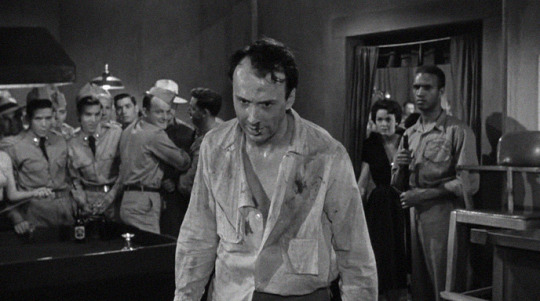
The Phenix City Story (1955)
Southeastern Alabama and southwestern Georgia are separated by the Chattahoochee River. Along the Alabamian banks of this river is Phenix City which, for over a century, became known as, “Sin City, USA”. Organized crime in league with the police department dealt in illicit drugs, fraud, rigged gambling operations, prostitution, and violence. These syndicates flourished on and around Phenix City’s 14th Street, and many of 14th Street’s patrons were Army soldiers visiting from nearby Fort Benning, Georgia (during the Civil War, deserting Confederate soldiers frequented Phenix City). So entrenched was Phenix City’s lawlessness that the city, state, and federal governments declined to do much to combat the organized crime. But in 1954, lawyer and Phenix City resident Albert Patterson ran for Attorney General of Alabama – campaigning partly on a platform to reform his hometown – and won. The Attorney General-elect’s assassination shortly before his swearing-in meant that Sin City, USA’s days were numbered.
With the events in Phenix City still in the news, Hollywood came knocking. Poverty Row studio Allied Artists envisioned an idea for a new movie – fast-tracking The Phenix City Story, directed by Phil Karlson (best known for his ‘50s film noirs) and a screenplay from Daniel Mainwaring (1947’s Out of the Past, 1956’s Invasion of the Body Snatchers) and Crane Wilbur (best known for acting alongside Pearl White in the 1914 serial The Perils of Pauline). Barely a year had passed since Albert Patterson’s assassination by the time of The Phenix City Story’s controversial release: this is a shockingly violent film for ‘50s Hollywood, and the film’s thirteen-minute documentary prologue was censored in the American South. Given Allied Artists’ lack of resources compared to the major Hollywood studios, The Phenix City Story is roughly acted, edited, and shot on occasion. But the film, shot on location and sometimes resembling a documentary, pulsates in its violent immediacy. Over time, it has shed its modest background to become a solid film noir.
Local lawyer Albert “Pat” Patterson (John McIntire) has lived in Phenix City for much of his life, privately despising the immorality plaguing downtown. Rhett Tanner (Edward Andrews) is the owner of Tanner’s Poppy Club – a den of booze and gambling where a bloody fistfight is shrugged off. Despite their disagreements, Pat and Tanner are friends and when the latter asks Pat to be part of a new citizens’ safety committee, he declines. Too many such committees have been created over the decades, sometimes masquerading as fronts for aiding criminal operations. However, Pat remarks, he is looking forward to something special. His son, John (Richard Kiley), is returning home from Germany after several years of prosecuting Nazi war criminals with wife Mary Jo (Lenka Peterson) and their children. When John, Mary Jo, and the children arrive, John is disappointed and Mary Jo is distraught at how Phenix City’s red-light district continues to be a hive of scum and villainy. A rapid turn of events involving the Patterson family’s friends and acquaintances – Ellie Rhodes (Kathryn Grant), Zeke Ward (James Edwards), and Ed Gage (Truman Smith) – will precipitate into a wave of assaults, bombings, and homicides that force Pat to run for Attorney General of Alabama.
Preceding most prints of The Phenix City Story is an introduction by journalist Clete Roberts, famous for his radio news reports, by then working for KNXT-TV (later KCBS) in Los Angeles, and is today best remembered for his role in two memorable episodes of M*A*S*H. Roberts, in the highly formal yet folksy journalistic style of mid-century America, interviews people who were close to the Patterson family or witnessed Phenix City’s violence leading up to Albert Patterson’s assassination. Roberts’ reporting is not as polished as it would eventually become. This makes the on-location prologue difficult to sit through, as Roberts asks too many leading questions and undeveloped questions that can be answered in one or a few words. The interviews do not flow smoothly between subjects. While these thirteen minutes make the rest of the film feel like a cinéma verité (generally, observational cinema) documentary within the mold of moody film noir, it can be grating to sit through. This review is based on a print of the film with the prologue included.
According to Ben Mankiewicz’s outro to the film on Turner Classic Movies (TCM) in January 2020, the prologue was placed into The Phenix City Story to allow the film’s violence – the film is not beyond brutal brawls and hoodlums murdering children – to bypass the Hays Code (which censored what could be shown in American movies until 1968, when it was replaced by the present-day MPA ratings system). If the film’s violence could be framed like a documentary, the censors agreed to allow depictions of bloodied characters, sultry women baring their legs, and a casual use of the epithet “nigger” by police officers on the syndicates’ payroll. The prologue – however flawed it is – allows The Phenix City Story to be as brutal as it is. Some theaters in the American South, noting that there was no requirement to show the longer version of the film (the one containing the prologue) they were provided, refused to show the prints with the prologue, deeming the Roberts interviews as inflammatory and impugning the South’s reputation.
Perhaps Allied Artists executives did not think the American moviegoing audience was ready for a diatribe on race relations, but one can see the United States’ historic racial violence at the film’s extremities, waiting to burst alongside the film’s general depiction of Phenix City’s criminal corruption. The film’s most horrifying moment is when Zeke Ward’s child is murdered by Tanner’s hitmen. Zeke, a black employee at Tanner’s Poppy Club who abandons his job after being barely involved on John Patterson’s side of a vicious clash, is targeted for being sympathetic to the Pattersons. That Tanner chose a black person as his first victim is no coincidence; when the police receive word of his murdered child, the officer on the line hangs up the phone and tells his colleagues: “Somebody just threw a dead nigger kid on Patterson’s lawn. Go out and have a look.” There is no urgent inflection in the officer’s voice, as if that call is considered less important because the victim is not white. As a partial aside, those few seconds make me wonder what the censors thought in that moment, as the Hays Code forbade “vulgarity and suggestiveness”, and recommended “good taste” in the depiction of law enforcement; nevertheless, enforcement over the use of “nigger” and other racial epithets did not have a consistently-enforced standard or discernible pattern of contextual exceptions. The Phenix City Story does not concentrate on race for the purposes of telling its story, but the white gangsters and their enablers imply – through their behavior, and if I may appropriate and slightly alter this contemporary line – that black lives could not matter any less.
The Phenix City Story is filled with unfamiliar faces; only those fluent in classic television (and I am not) might squint in half-recognition of the actors involved. There are no bravura performances here, but John McIntire and Edward Andrews – as the elders of this tale, Albert Patterson and Rhett Tanner – stand out from an otherwise lackluster crowd. George White’s (1946’s The Postman Always Rings Twice, 1947’s Green Dolphins Street) editing is consistent. To his credit, The Phenix City Story, outside of the prologue, is never dull as it blasts away at a rocket’s pace. But during the film’s most violent moments, White’s editing fails to hide some of Allied Artists’ low-budget limitations. In the moment where Zeke’s murdered child is tossed out of a car, White fails to hide the fact that the child is a dummy. On my first viewing, I found myself confused about what the dummy was supposed to be. Was it a plastic alligator, a wooden log? Whatever it was, it looked so terribly phony that I couldn’t contain my laughter. Cut to a close-up of the child’s lifeless face. I realize my laughter arrived at the worst possible time. Good thing I watched this film alone. Nevertheless, a better attempt at editing or an alternative angle could have deemphasized the artifice here and spared me (and probably many others) the mortification of laughing at the worst possible time.
The collaboration between director Phil Karlson and screenwriter Daniel Mainwaring led The Phenix City Story down the path of film noir. Karlson’s experience with film noir and Mainwaring’s expertise in tackling material taking place in small-town America gift this film its lurid, sweltering Southern atmosphere. The Southern hospitality disguising traces of malevolence, the notion that residential Phenix City is supposedly far away – geographically and culturally – from 14th Street, and the familiar banter between acquaintances who know each other’s names and families help The Phenix City Story feel authentic to the audience. It makes the film’s violence personal, even when the Pattersons are nowhere near the camera. Karlson, with journeyman Allied Artists cinematographer Harry Neumann (1940’s Midnight Limited, 1959’s The Wasp Woman), implement the chiaroscuro lighting characteristic in film noir to chilling effect – most notably as John Patterson walks into 14th Street on his first night back to visit the drugstore.
Alabamians who lived through or close to the times of The Phenix City Story say that the film achieves the atmosphere of what life in Alabama was like in the mid-1950s, even though the film contains numerous fabrications to dramatize the narrative. The real John Patterson became Governor of Alabama in 1959 and, ironically in comparison to his depiction here, was a segregationist politician. But Patterson, who later renounced those segregationist views, was considered a liberal figure in Alabama, and he was immediately followed by George Wallace. Following its prologue, The Phenix City Story convulses in rage. It denounces fully the criminal skullduggery that made possible a century of ill repute, though not the white racism that it barely brushes. And despite its technical hiccups and occasional dubious acting, it is a prime example of Southern-set film noir.
My rating: 7.5/10
^ Based on my personal imdb rating. Half-points are always rounded down. My interpretation of that ratings system can be found here.
For more of my reviews tagged “My Movie Odyssey”, click here.
#The Phenix City Story#Phil Karlson#John McIntire#Richard Kiley#Kathryn Grant#Edward Andrews#James Edwards#Lenka Peterson#Biff McGuire#Truman Smith#Clete Roberts#Daniel Mainwaring#Crane Wilbur#Harry Neumann#TCM#My Movie Odyssey
2 notes
·
View notes
Text
Wrong | 1.
The smell of crime reeked through your city although you were a controlled assassin with limits, you tried your hardest to use your sense of justice to step up and be their vigilante for better or for worse, unfortunately, you have to get involved with the city’s most notorious mobster, Tom Holland.
Pairing: Tom Holland x Y/N | Parts: 1 2 3 4 5
Warnings: mob!AU, violence, gore, teasing, swearing, sexual themes, drug references, alcohol abuse, death, assassin!reader
Word Count: 2k
clothes off ‘cause she so soft
this ain’t a fair fight
One; The File, Fire & Flames

Echoes whispered through the paper thin walls, the cold breeze flowing through the open windows causing your skin to react, creating small goosebumps as the stealth catsuit you wore barely covered the exposed skin of your upper body. It wasn’t a logical choice really, but you didn’t have a say.
Your stomach churned with a multitude of emotions, unable to pinpoint just one as the tension in the night air grew thicker almost suffocatingly.
Clenching your jaw to suppress any faltering emotions from showing on your face, you strutted confidently in your stiletto heels down the poorly lit hallway and towards his office.
The only light source guiding your way was the iridescent moonlight that shone onto the marble flooring, reflecting onto many of his prized possessions that were on display in glass cases, not too practical.
You recognized the guard as your close colleague Sebastian, nodding to him dismissively as your hand came in contact with the metallic handle twisting it ever so slightly.
“Be careful, he’s not in a good mood,” His calloused hand clasped around your wrist tightly preventing you from entering, ripping your gaze off the patterned wooden door and to him, you forcibly removed his grip. Your faces merely inches apart as you calculated your next words.
“I think I can handle it.” A growl fell from your lips, surprising yourself in the process at your hostility as his eyebrows furrowed, his usual glimmering blue eyes now dull and bloodshot.
Your lips parted, struggling to swallow the lump in your throat inaudibly before pushing the door open, entering the ‘famed’ room that your colleagues always praised claiming miracles happened in there, but you refused to believe this as your own experiences proved the opposite, knowing how much of a curse it really was.
The skin coloured case file that sat under the table light on the desk was the first thing to catch your eye. Totally ignoring his lingering presence in the room, you strode towards the table inhaling the wretched scent of smoke whilst picking up on the ashtray that embers were still brightly burning out.
Brushing your fingers nimbly over the folder before picking it up, your stomach dropped as your eyes glazed over the file name.
“James, I can’t do this one,” You stated while flicking through the pages of research pausing at the headshot image of the notorious mobster with brunette curls and chocolate eyes, your spine shivered at the mere thought of him.
Usually, the target's weaknesses were listed underneath their name, however, the list was absent from the file causing you to wonder just how deadly this guy really was. How many people had he murdered in cold blood?
“And why is that?” He inquired, his voice coming out hoarser than you’d imagined obviously from the side effects of smoking as he ominously came forward into the light.
His auburn hair was messier than usual, the wrinkles on his forehead and the corners of his mouth more prominent than ever. His eyes scared you the most holding answers to questions you couldn’t even begin to comprehend.
“I’m not going on a suicide mission,” You retorted, dropping the file onto the desk disinterestedly as possible hoping the slither of mercy he possessed and your ability with words would save you from your inevitable fate if he refused to work with your stubbornness.
“It’s either you or your family,” He shrugged nonchalantly, the words rolling off his tongue too smoothly to be an empty threat. Your throat constricted at the mention of your relatives, chest heaving with what you could now recognize as vexation.
“Y/N, you’re our best operative,” He continued on, attempting to persuade you as he sat comfortably in the chair behind the desk eyeing your every move and reaction to his lethal words. You resented him for turning you into a weapon, once you saw the world that way there was no going back.
“That doesn’t make it right,” You retaliated, slamming your hands onto the desk violently, accidentally denting it with the pressure of your fists.
“Don’t step out of line now girlie,” He warned, slowly sliding his pistol across the table, the irritating noise of the metal against the wood throwing you off.
Leaning forward, he yanked your forearm down onto the table, bunching his other hand in your hair as he brought your face dangerously close to his
“If you’re not careful, I’ll inject that serum right here,” He hissed, pressing his fingers on your pulse point, your eyes widening as he let out a chuckle at the exact reaction he would hope to coax out of you before throwing your head back.
“You sick bastard, don’t touch me.” You seethed, trying to control your anger by clenching your fists, digging your nails into the palm of your hand and drawing a red substance.
“Sebastian, take her away,” He spat as Sebastian entered the room, pinning your wrists behind your back harshly. You could’ve easily dropped him but you had to earn their trust, no matter how long it took.
“You promised me a call asshole!” You yelled out, striking a nerve in you as you loathed broken promises, you had one too many of them in your life.
“I think it’d be better if they still thought you were dead.” He responded smugly, a smirk creeping onto his face while you struggled against Sebastian's grip restraining you from slapping the smirk off James’s face. He threw you over his shoulder, hauling you out of the room before you did anything else out of recklessness.
“Quite a nice little performance you put in on there doll, I’m impressed,” He commented while locking the door behind him, letting you crawl off him, your heels coming in contact with the ground again.
“Not all of that was a performance,” You mumbled, peering up at him with glazed over eyes unsure of how to handle your bubbling over emotions properly as you were never quite taught how it was one of your weaknesses.
“The only way you’re going to get out of here is to kill him and burn that contract,” He sighed, running his hand over his light stubble as he watched the cogs turn in your very complicated mind.
“What right do you have to tell me how to escape? when I've been here longer than you,” You spat, pointing your finger into his chest with every syllable pronounced out of pure spite.
“Y/N tread carefully, I’m the only person willing to help you here you don’t want to lose that.” He crossed his arms over his chest, glad that the room behind him was soundproof as he stated the facts.
“Do you?” He questioned, but you knew too much was at stake to be retaliating against him just because you were in a bad mood so you swallowed your pride begrudgingly.
Cursing under your breath, you turned away from him pondering your options as you grazed your fingers over the bleeding palm of your hand revelling in the sting it caused. Pain brought out your most undesired emotions.
“I’ll have the file delivered to your room tomorrow morning,” He informed you as to your lack of reply left a lot of questions, for him anyway.
“I want it tonight.” You sharply ordered beginning to strut down the atmospheric corridor again, away from Sebastian and that bastard James.
The multilayered manor you lived in, which some people would call a paradise was more like a jail cell to you. Staring at the many different prototypes of latex catsuits that hung in your closet a sigh left your lips. From what you gathered the city had dubbed you ‘Black Cat’. The number of reports and televised criticism on you was deafening to your ego however you expected this, you knew how the world thought about vigilantes. Especially the corrupted police that pathetically called themselves the justice system, because of them media outlets were desperate to figure out your alter ego, much to your dismay. James kept them off your tail for the pure reason of entertainment.
Propping yourself up on your bed, your sensitive ears picked up the sliding of something under your door. Head snapping towards the direction, you furrowed your brows at the skin coloured file that lay strewn about on the tiles. The silver and reflective name of Tom Holland shining into your eyes irritatingly so.
Picking it up, you opened the file pulling out the paperclipped sheets of paper that had valuable information about his background on it. Your eyes scanned over the first page. After an hour or so of breaking down his profile, you found some crucially important points; He never went anywhere without his right-hand man Harrison Osterfield, His whole familiar were involved in the drug industry which also made them one of his weaknesses or so you assumed yet it was dangerous to do so in situations like this and he had an affinity for strippers that didn’t surprise you.
Dominic and Nikki Holland were out of the picture, none of their limbs or bodies intact enough to be autopsied. They had both left on a train to negotiate their next payload when it exploded, the assassination attempt deemed successful. You recognized the symbol on the detonated bomb realising it was James’s handiwork.
The Holland twins, Harry and Sam were both trained in hand to hand combat obviously it wasn’t military training but the second best thing. Luckily one of them had a girlfriend but you weren’t going to notify James about that since he would go to desperate lengths to torture people for fun and use them as leverage, you had firsthand experience in that.
Claire Hope, 19 Ridgewood Drive, imprinting the address in your memory you resealed the document. It was the appropriate occasion to utilize the stealth suit for this slight detour.
Zipping up the suit whilst standing on the ledge of the windowsill, you inhaled the stale but refreshing air of the night letting the iridescent moonlight beam onto your face, eyes fluttering shut in a moment of contentedness.
Turning on the balls of your feet, you positioned your arms in a T movement allowing yourself to plummet backward without a single hesitation in your action due to your cat-like reflexes.
The masks built in GPS proved its efficiency in times like this, tracking targets became easier with each new piece of manufactured tech James had stolen.
Scaling the roofs was the effortless section of the mission as you concentrated your focus on following the crimson arrowhead that guided you to the address through the mask, allowing you to do so without any unwanted interruptions.
As you began to accelerate approaching the girl’s house, boisterous ear-piercing sirens could be heard ringing out. A screech ripping through your throat as it threw you off. Dropping down low onto the roof as you accidentally gained the attention of the people swarming around the house. Familiar scarlet and azure-tinted lights flickered around continuously on a loop.
“Fucking cops.” You hissed under your breath, eyes widening interestedly as an ambulance pulled up outside of the house, the shrill and frantic yelling of the paramedics almost deafening. You’d think they’d be trained in situations like this to handle it calmly.
Watching intently as paramedics exited the house, you noticed the young woman you could recognize as Claire having an intense seizure on the stretcher.
“She’s going into cardiac arrest!” The male exclaimed signalling the others to aid him, getting ready to perform CPR as they placed the stretcher onto the gravelly ground of the pavement, their covered hands on her chest putting pressure there every couple of seconds.
Your breath hitched as the sudden realization hit you, you weren’t the only one assigned to this mission.
You ears pricked up as the smallest clinging noise caught your attention, squinting your eyes you saw a shiny gold encrusted ring next to her lifeless hand that must’ve slipped off as they placed her body onto the ground enticing you even more than before. Was she apart of the 7 rings?
#tom holland#tom holland blurb#tom holland smut#tom holland x reader#mob!tom#mob!tom holland#mob!tom holland x y/n#mob!tom holland x reader#mob!holland#mob!au#tom fic#tom holland fanfic#tom holland fanfiction#tom holland imagine#tom holland imagines#tom holland fluff#peter parker#peter parker imagine#peter parker x reader#peter parker headcanons#spiderman#spiderman hoco#harrison osterfeild imagine#mob!tom series#marvel#mcu#avengers endgame
208 notes
·
View notes
Text
Darth Vader and the violence against imperial low-ranking soldiers (Old Trilogy)
I have habit of re-reading star wars comics & books, mainly focusing on Darth Vader. I have quite clear idea of his character, shaped by various sources AND my own thinking & analyzing made over the years.
One of the things that never sit well with me is idea of Vader using violence against low-ranking soldiers for no fair reason.
Don’t get me wrong, Vader killed a lot of imperial soldiers, there is no deny of that. Either he sent them on very dangerous - sometimes simple suicide - missions without regard for their life or because “there was no mercy for failure among the Imperial military”. Vader was the ultimate executor of those who either betrayed Empire or were incompetent. Looking how the whole Imperial Army became corrupted, how so many people put their own ambitions and gains over the welfare of the Empire, Vader’s ruthless presence was essential to keep the whole military in check.
And Dark Lord of the Sith was effective at his job, to the point that some characters - like bounty hunter Dengar - thought about him as a really busy man, who “had his own political agenda, men to command, an Empire to run“.
As much as Vader lacked patience for fools and tolerance for failures - what usually resulted in someone’s death or at least force-choking - in the movies alone he never punished or threatened imperial low-ranking soldiers. All the verbal & physical violence was directed at officers, especially those with high status. At admiral Motti, for being disrespectful for Vader’s belief about Force, at admiral Ozzel for incompetence, at captain Needa, for too hasty reporting success (catching Millennium Falcon) that turned out to be failure, at just-promoted-to-admiral Piett - if he failed him again. At Director of the Advanced Weapons Research, Orson Krennic, for being more focused at competing with Tarkin rather than performing a recommended task. But common troopers? Nope.
Frankly, the Old Trilogy gave us very noticeable contrast in Vader’s behaviour that always depended on with whom he worked. The undertone of famous scene during Imperial Meeting in ANH was much different than, let say, boarding Leia’s ship. For better analyze, here a short summary.
In A NEW HOPE:
After stormtroopers took over the rebel ship, the first thing Vader did was looking for enough alive rebeliant to interrogate. The few who fell in the first phase of imperial attack were dead, Vader didn’t say anything, just moved on. Stormtroopers went with him.
Next scene, Vader personally interrogated Antilles after his trooper reported that “The Death Star plans are not in the main computer”. Not satisfied with rebel’s lack of cooperation, Vader ordered “Commander, tear this ship apart until you've found those plans, and bring me the passengers! I want them alive!” He sounded angry (then again, the man can’t say a word without being terrifying) but there was no threat what will happen to stormtroopers if they will not find the plans. They didn’t, as far as we know, no imperial soldier died in result.
Stormtrooper captured instead Leia, Vader had no patience for her lies and imprisoned her. Commander Daine Jir* pointed out flaws in Sith’s plan. No violence against him or against commander Praji*, who reported “Lord Vader, the battle station plans are not aboard this ship, and no transmissions were made. An escape pod was jettisoned during the fighting, but no life-forms were aboard.” Vader’s final words in that scene, “There'll be no one to stop us this time” sounds not only confident about the future; the use of “us” is an interesting choice of words. No stop “me” or “Emperor’s plans” or Empire as a whole. Us. Vader referred to himself AND his troopers who hunted those rebels (and plans of Death Star) for a while.
During meeting with the most important Imperials on Death Star, minute or two after showing up with Tarkin, Vader was force choking Motti while saying the famous ��I find your lack of faith disturbing”. If Motti didn’t act so arrogant, Vader wouldn’t feel obligated to prove him wrong. There is visible contrast between Vader on battlefield (surrounded by his own soldiers) and Vader surrounded by high-ranking officers. The Dark Lord of the Sith is one of the most powerful being in Empire yet he is “outsider” during the meeting. There is no place at table for him, he isn’t part of military nor government the way Motti, Tagge or Tarkin were.
During battle of Yavin, Lieutenant Tanbris* informed “We count 30 rebel ships, Lord Vader, but they're so small, they're evading our turbolasers.” Vader’s reaction? “We'll have to destroy them ship to ship. Get the crews to their fighters.” Once again, Vader used plural “we”; he was going to join his troopers in fight against rebels. [Side note, since Tanbris is part of Vader’s own crew, it makes sense he went straight to his boss, not to any official commander of Death Star. Then again, the 501st Legion wasn’t personally responsible for protecting battle station but Vader involved himself in fight on his own because no imperial high ranking officer - be it Tarkin or Motti - either didn’t think about using TIE fighters or were too arrogant to believe rebel attack may be dangerous to them]
Vader met two imperial pilots on his way to his personal TIE. He calmly told them “Several fighters have broken off from the main group. Come with me.” Not much emotions, no threats what will happen if they fail him. During fight, he only told them to cover him while he is dealing with rebels.
So, in ANH we have one a bit force-choked admiral, no threats against low ranking stormtroopers or imperial pilots. Vader doesn’t have patience for Motti’s arrogance & bullshit, but he doesn’t mind Jir’s insight and is one of few imperial high-ranking officers who takes part in dangerous fights against enemy. Vader doesn’t speak much with other high-ranked officers (beside Tarkin) and in final battle he doesn’t just sent people on front line - he personally take action to secure Empire’s victory (and if not for Han Solo, he could succeed) while Tarkin, underestimating enemy, put faith in superiority of the Death Star.
In The Empire Strikes Back, Vader’s status in imperial army changed. Until now he operated outside of military hierarchy and though he was always the second-in-command of Empire, now he was officially titled as Supreme Commander. Also, Vader already knew Luke is his son and became obsessed with finding / capturing him. The idea of having son at his side, made Vader closer to idea of overthrowing his master and thus “tread on thin ice”. Because of the “promotion” to official Supreme Commander, for understable reasons, we see Vader more around officers than stormtroopers. Still in TESB:
the first man killed by Darth Vader was admiral Ozzel. Reason? Incompetence. Even then Vader’s line “you failed me for the last time” indicates that it wasn’t the first mistake that Ozzel made. Unfortunately for the imperial officer - due to his obsession with finding Luke - Vader lost patience more quickly than usual. (General Veers tried excused admiral’s mistake but Vader didn’t punish him in any way for speaking on behalf of another officer who clearly never was favored by Sith Lord; captain Piett get promotion)
The Rebel Base was under attack; though in the movie alone we didn’t see Vader in battle action (not like in Star Wars Battlefront), it’s clear he joined troopers at some point and went into Rebel Base before that was secured.
Later, Vader sent pilots after Millennium Falcon that hides in asteroid field which is like, the most(?) obviously cruel thing he did to common troopers, as far as movies showed. Then again, ANH already proved how high ranking Imperials do not care for people in general and Vader lack of care for wellbeing of subordinates does not stand out that much from “imperial norm”. What I mean, we still did not see him tormenting troopers for fun or act out anger by hurting them but using available forces in military operation that was important to Empire (and Vader’s wish to save find son). This does not excuse the callousness of Vader’s decisions but there is no malice towards troopers per se. He is doing what imperial officers would do - use troopers to archive victory for the glory of Empire.
Still, Vader does not mind use bounty hunters and mercenaries to do the dangerous job. Something that does not always sits well with imperial officers (Piett). If Vader could hear or feel in the Force admiral’s complain, he did not show any anger or care for it.
Captain Needa was second victim of Vader. This one death seems like unnecessary violence, especially since the officer was presented quite as honorable man (willing to take all blame on himself). But Needa reported capturing enemy’s ship that turned out to be not truth and was killed in result. No mercy for failure, after all. Still, no man under his command was put in harm way, as far as we know.
Later Vader was busy on Bespin, with the torturing Han Solo and fight with son. When once again Millennium Falcon run away (and the supposed ), the face of admiral Piett makes it clear, the man was painfully aware he failed. Yet Vader did not kill nor threaten him in any way. Maybe Piett was to some degree liked by Darth Vader (he chose him after all) or maybe Piett was truly lucky man cause the Sith was too busy with his emotional/family conflict to care. Piett survived and was once again seen in RotJ.
Return of the Jedi puts once again Vader in different perspective. This time the focus on Sith does not involve much military matters, now his story resolve about personal conflicts; duty vs desire, master vs son and so on. Of course, we still can see Vader working well with admiral Piett or warning / threatening Moff about delays in construction of Death Star but he had no chance to take active part in combat like in previous movies.
So, in the Old Trilogy there is not much hints Vader used physical or verbal violence against low-ranking soldiers. He was willing to sacrifice their life for “greater good” of Empire (or his own plans) but as far as movies shows, he did not force choke them for mistakes or talking back, like he did to Motti or director Krennic in Rogue One. And this shapes a lot of my thoughts about Vader, his relationship with other imperials and how he fit - or not - the imperial norms.
Of course, comics and books presents the matter in various ways but this is something for another meta(s). A meta(s) I hope to write in nearest future. For now, remember that the higher in rank someone is, the more critical, judgmental and strict Vader became.
* the names of imperial soldiers comes from additonal sources.
#star wars#darth vader#vader and stormtroopers#imperial officers#my analysis#my meta#yay i finally write this one it sit in my drafts for like months already#basicly i despite the idea that vader is using violence against common troopers for no reason#he will send them in dangreous places on suicide mission yes#but he is not gonna out of his way to scare or hurt or humilate them
33 notes
·
View notes
Photo

PROFILE LOADED • • • 《 RYEO SOLJU 》
“On the surface, RYEO SOLJU is a twenty-six-year-old PART-TIMER. Dig a little deeper and you’ll discover that she’s also a HITMAN that goes by the alias AURORA. Her allegiance lies with PHOENIX.”
TW SUICIDE, PARENTAL DEATH, GUNS, BLOOD, MURDER
《 WHO ARE YOU? 》
“When life gives you lemons, Ryeo Sol-ju,” the little girl’s father spoke in a mellow tone, “do your best to squeeze them into people’s eyes.”
At that time, Sol-ju could not grasp the meaning or the message her father tried to convey. For one, she was only three years old and, two, it was her birthday — a day of celebration, not cryptic messages and even more dubious presents. To this day, she can vividly remember her small hands cupping the ripe, yellow fruit her father gifted to her, with confusion deeply set in her brown eyes as she stared at the tall figure of her father. To her befuddlement he responded with a smile, one that he showed to no one but his one and only daughter.
No, at that time, she had no idea what his words meant but when she turned fifteen, she finally understood.
Two weeks after her 15th birthday, life gave her a lemon made of steel and she learned that its nectar was, metaphorically or otherwise, faster than light itself and most importantly – it was effective and explosive. The day she was supposed to take her own life, just moments before her parents would perish at their own will instead of succumbing to the will of their captors, Ryeo Sol-ju discovered her lemon, hiding under the sofa, and she fought for the life she must have been meant to keep.
The lemon’s name was Glock 21 and it followed her every step for years to come, after she shot her way out of her family home where her parents’ bodies remained.
Despite her strict upbringing and violent climax, Ryeo Sol-ju never thought of herself as a person struck by tragedy. Rather than linger on what was, she decided that by continuing her parents’ heritage she would honour them far better than she ever could with tears and mourning. Raised to never look back unless she is danger, Sol-ju is as clever as she is resilient, and she has no interest in settling for less if she would be greatly inconvenienced.
She had learned early on that, should one follow a path of righteous violence, one must be willing to risk everything, including their own life. Yet, despite that, one could never describe her as careless. She might have got it from her mother, really, for Sol-ju never lets her guard down and she can rarely be found without an escape plan from any situation (or location). While she comes off as cold at times (merciless, even, was a word some used to describe her), she is certainly not detached from her humanity and soft spots hide somewhere deep inside her heart. One would just have to be determined, and patient, enough to dig deep and long to find them.
《 HOW DID YOU GET HERE? 》
Looking back, Sol-ju thinks it comical that at the most crucial point of her life – namely two weeks after her 15th birthday – it was death that offered her the most important choices. The first choice was taking the suicide pill she had been grasping behind her back, or dare to reach for the handgun discarded under the sofa and risk everything for the infinitesimal possibility of escaping.
After locking her eyes with her father, whose quaint but reassuring smile told her that while he and his wife had to perish and would do so within a moment’s time, Sol-ju was meant to live. It had all been planned. Without a chance to bid farewell to her parents, Sol-ju took her cue and chose the second option — throwing, and then rolling her body towards the sofa, while her father worked on a short-lived distraction, Sol-ju reached for the gun and fought for her life. The last of what she’d seen of her parents was her father getting shot by the officer and her mother consuming the cyanide. The last of what she’d seen of the officers was the four of them attempting, much to their incredulity, to subdue a petite teenager, yet failing as their bodies fell back or forward after being shot. The last of what she’d seen of herself while still in her family home was a dirty, exhausted and terrified face in the broken mirror, and a messy hair soaked in sweat and blood. The last of what she’d seen of her house was an image of a fire’s rage consuming all under its path.
How is it possible that a fifteen year old child managed to take down four government officers, one may wonder? The thing is, she was never an ordinary child.
Today, she goes under the alias Aurora, and a number of fake names. Her current, official name, as listed on her documents, is Kim Sarang, and her birth place is listed as Pohang, South Korea. And although her official (and philosophical) alliance does not lie with any known anti-government organisation, the CIA, NIS, and Mossad have classified her as a ‘political terrorist’ who is known to have aided the war fronts, as a mercenary, in several countries.
Yes, who is she?
She is Ryeo Sol-ju, born October 1992, in a small North Korean village near Manpo city, to dissident parents. It was a village so small that it did not even deserve a name. It was her home, yet it was also the beginning front of her battleground. Ryeo Sol-ju’s maternal grandfather was a decorated Korean War veteran who fought for the North’s forces for years, having left his wife and five children behind for the sake of blind, political ideals. One of his two daughters would be married off to an officer, one would die young of tuberculosis, the eldest son would marry off to the city, one would become a family doctor, and the youngest of the sons, Ryeo Myung-soo, would take up a life path directly opposite to his father’s.
Ryeo Myung-soo would become a rebel. He, with a handful of well-armed, intelligent, dissident high school classmates, would found North Korea’s small, but insidious ‘terrorist’ cell named ‘Saeui Nagwon”, a more literal interpretation of the flower ‘strelitzia’ which, ironically or not, symbolised liberty. The cell was meant to overthrow the government and restore prosperity in the country. In 1991, Myung-soo married a woman from their organisation and they welcomed their one and only child in the autumn of the following year.
Named Ryeo Sol-ju, the daughter was raised into the life of her parents and their dissident allies, whose numbers dwindled as the years went buy. The first lesson Sol-ju learned from her parents was that of the ‘lemon’, and the second was how to fire a gun. She was only six years old when she learned how to operate a pistol, eight and a half when her mother started teaching her the art of thievery, ten when she started taking up combat skill lessons and eleven when she was taught about the ‘suicide pill’.
Sol-ju was somehow never too young to understand. She studied Korean history, and politics, religiously and all that her father taught her made perfect sense to her. When she grew up, she wanted to be just like her parents. In her eyes, they were fighters (and protectors) of freedom and the fact that they were involved in the deaths of their opponents – all government officials – unperturbed Sol-ju. The government was the enemy, after all.
Sol-ju never stopped believing that. At fifteen, when the government’s officials captured her mother, father and herself in their small, village home, Sol-ju thought that death was inevitable. Either she took the pill or she allowed herself to be publicly executed. Yet. In the last seconds she found salvation – a Glock 21 abandoned under their sofa.
She was the only one to come out of the ordeal alive yet this did not stop her. She was immediately taken in by the remainder of Saeui Nagwon and further trained into who she would become before turning twenty - one of the most infamous, Asian mercenaries. By that time, Ryeo Sol-ju already found herself on the North Korean authorities’ list of the ‘most wanted’, yet every time the officials got remotely close to her she would slip away from their grasp.
At twenty, when Saeui Nagwon’s numbers dwindled but to a dozen members, Ryeo Sol-ju was sent off abroad, where it was hoped she would be more successful in aiding others fight against their respective, oppressive governments. Saeui Nagwon was losing its grip in North Korea, but it did not have to mean the end of the finest of its members who could escape and promote their political ideals elsewhere.
She spent five years fighting abroad before being summoned back to Korea. After such a long time in war, she had difficulty adjusting to ‘normal life’, but the normalcy, unsurprisingly, lasted for a very short time. Now wanted by international agencies accusing her of terrorism, Sol-ju knew that if her father’s organisation was ever to rise again, the remaining seven members would have to go in indefinite hiding until they could reunite for one last strike. That was how she ended up as a member of Phoenix — the gang’s brand new hitwoman who seems to have sprung up out of nowhere. While only a select few of the gang’s high-ranked members know who she is, everyone else knows her as either Aurora or Sarang, a sporty and quirky arms enthusiast.
1 note
·
View note
Text
A reasonable guy’s reasonable opinion on why stronger gun control in the US would be silly and solve nothing
Like it or not, we are living in an unprecedented age of escalating gun violence in the US. Regardless of where you lie on the political spectrum, this much is undeniable. And with this rise in gun violence comes a debate on what to do about it.
I don’t consider myself right-wing. Granted, I don’t exactly consider myself left-wing either; I’d say I’m a centrist. But I do tend to lean left, and I was raised liberal. I used to be on the other side of the fence when it came to gun control, but as I got older and my views changed and as I became interested in firearms and learned more about them, my position on this issue eventually flipped.
So, without further ado, here’s my reasonable opinion on why stronger control in the US would be silly and solve nothing.
Point 1: What exactly is an assault weapon? The hell if I know.

The image above isn’t lying to you. The rifle on top in the image above is above is of course an AR-15, likely a Colt LE-6920 specifically. It is a semi-automatic only rifle chambered in 5.56x45mm NATO, and it’s pictured here with a 20 round magazine. For those of you who aren’t very familiar with guns, the important thing to take away from that is that it’s a rifle and that it will fire one bullet (and only one bullet) every time you pull the trigger until it runs out of ammo. In order to fire another bullet, the trigger must be released and then pulled again. This is as opposed to what are referred to as automatic or fully automatic guns, which will continue to fire as long as the trigger is held down, burst-fire guns, which work almost identically to semi-automatic guns except that they fire more than one bullet every time the trigger is pulled, bolt action, pump-action, or lever-action guns, which after firing a bullet must have a handle, lever, or pump mechanism manipulated in some way in order to load the next round before the trigger can be pulled to fire another bullet, or select-fire guns, which combine two or more of the previously mentioned modes of fire.
The bottom gun is a Ruger Mini-14 Ranch, pictured here in the 5 round variety, though 20 round varieties are available. Like the AR-15 above it, it is a semi-automatic only rifle chambered in 5.56x45mm NATO. For those who don’t know, a gun’s ability to induce severe trauma in targets (known as “stopping power”) is primarily reliant upon the cartridge it is chambered in. Since these guns both use the same cartridge, their stopping power and in essence their lethality is the same. If anything, the Mini-14 has a slight advantage over the AR-15 as it has a two-and-a-half inch longer barrel, and thus the expanding gasses produced by burning off the cartridge’s propellant have more time to push the bullet up to greater speed before it leaves the barrel.
Yet the AR-15 is an assault weapon, and the Mini-14 is not. Why is this?
This is because the term “assault weapon” doesn’t really refer to anything particularly specific. It’s a vague, nebulous term used to scare people who don’t know any better into being afraid of something that they don’t understand in order to push an agenda. Thus when it comes to codifying what exactly an exactly an assault weapon constitutes in regards to the law, things get very murky and very, very messy very, very fast.
(As a quick aside, the term “assault weapon” is not the same as “assault rifle”. “Assault rifle” is a technical term that applies specifically to rifles while “assault weapon” is an incredibly vague term that applies to any category of weapon. Specifically, an assault rifle is a selective-fire rifle chambered in an intermediate caliber, meant to provide the advantage of greater range, accuracy, penetration, and stopping power of a rifle over a submachine gun, while being more compact and controllable in full automatic fire than a full-length, full-power rifle. As such, the term “assault rifle” is generally unused outside of military applications.)

In law, assault weapons tend to end up being classified based on secondary features rather than on anything having directly to do with their actual killing potential. Things like pistol grips, collapsible and/or folding stocks, “high-capacity” detachable magazines, heat-protective handguards, and accessory rails, that don’t increase a weapon’s lethality in any way. What these features are actually meant to do is improve the weapon’s ease of use, and make it so that the operator can operate the weapon and acquire targets faster while under extreme stress (meaning when someone is shooting back at them). In the case of a mass shooter using this kind of weapon, when it comes to shooting at a bunch of unarmed civilians who aren’t shooting back at you, these features don’t make any difference at all. It doesn’t matter if the stock is fixed or collapsible; as long as you have a deadly weapon and they don’t, that’s all that matters. And in the situations where these features do make a difference, i.e. dealing with law enforcement, these fancy-schmancy tactical features are no replacement for shooter skill, as any shooting course worth its salt will drill into you. These features will not make you a better shooter; they can only augment what skill is already there. And a skilled shooter does not need these features in order to pose a threat, either; they will be able to put up a good fight using a weapon without any “assault weapon”-type features at all. Sure, it’s nice to have a stock that you can adjust exactly to your preferred length of pull and it’s nice to have a red dot sight that lets you acquire targets faster than with irons or a scope with a fancy reticle that makes it easier to estimate how far away your target is, but none of that is necessary. Throughout the history of warfare there are boundless examples of people with inferior equipment prevailing through the use of superior skill, tactics, and strategy. And if you think that a civilian shooter can’t outperform a police office or soldier, you’re sorely mistaken; the vast, overwhelming majority of police departments and military units, including in the United States, only have enough funding to provide officers and soldiers with the absolute bare minimum amount of training required in order for them to be considered duty-ready or combat effective, requirements which are not particularly high. The only officers and troops who receive intense, quality training with weapons handling are some SWAT officers and most special operations forces. Most civilian gun enthusiasts train a lot harder than your average soldier or police officer, so it’s fortunate that the majority of mass shooters (with some exceptions) have turned out to be rather gun-dumb.
What all of this amounts to is the term “assault weapon” being nothing more than a media buzzword made up to scare people. They’re trying to convince you that if it looks like a military gun then its sole purpose must be to kill people, when the truth is much more complex than that.
Point 2: Banning firearms cannot and will not prevent dangerous people from owning guns.
Yes, I know. The whole “criminals don’t play by the rules” argument is tired one. But that doesn’t make it any less true. And furthermore, I don’t think people realize just how big a deal it truly is.
There is a large and well-developed black market for firearms in the United States, as well as in other countries. These guns are already in the hands of criminals, who are selling to other criminals, and thus these guns exist completely outside of the federal system of background checks currently in place. All one has to do is know somebody who’s selling or know where to go on the dark web, as well as of course have the money to pay for the product.
And beyond that, we have homemade guns. Yes, you heard me, homemade guns. People seem to have forgotten those 3D printed guns that made the news just a few years ago. And that’s only the tip of the iceberg. Functional weapons can be produced in a variety of ways from a variety of items. All it takes are some household items, maybe a tool or two, and a basic understanding of the principles involved.
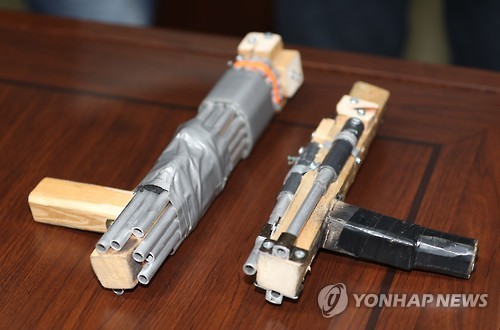
^One of these was used to kill a police officer in South Korea in 2016.

^A handheld, single-shot .410 shotgun made out of a paintball marker.
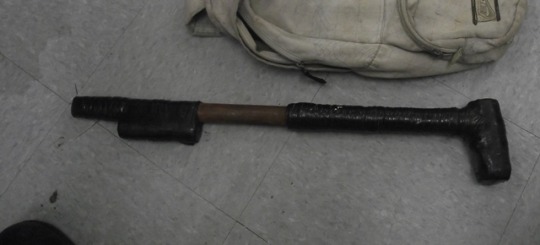
^A 12 gauge shotgun made out of a couple pipes and some duct tape.
With the digital age in full swing, such weapons are only going to get easier for the average Joe Everyman to construct as 3D printable designs show up on torrenting websites, and instructions for more conventional designs that can be made out of a few dollars worth of hardware store goods are easily available for anyone to find.
The ultimate result is going to be that the only people with guns are going to be the police, the military, and violent criminals, leaving you more or less completely defenseless during the time it will take for help to get to you in the event you get attacked by someone with a firearm.
Point 3: Guns were around long before any of this was a major issue.
This is a big one that often gets ignored by people on both sides of the issue, but it’s an important point to bring up: this epidemic of gun violence in the US is a new thing, but the presence of guns, even of scary, tactical, “military-style” weapons like the AR-15, is not. Something changed to cause this outbreak of violence, and it wasn’t anything like there being more guns or more dangerous guns becoming available to the public. If anything, the presence of guns in the US has slowly shrunk over the decades. Prior to 1986, any and all American-made fully-automatic machine guns were perfectly legal for anyone to own, in the Sixties you could mail-order surplus anti-tank guns from WW2 for forty bucks or so, and before 1934 there were basically no restrictions whatsoever on what kinds of weapons a civilian could privately own. Yet in spite of this slow decrease in the average American’s access to various firearms, gun violence has skyrocketed.
Something cultural is at the root of our gun violence epidemic. Banning firearms or banning specific firearms or otherwise further restricting access to firearms is nothing but a band-aid solution. If violent and unstable people lose legal access to guns, they will not stop being violent and unstable and wanting to kill people. These people will simply transition to using other forms of weaponry to carry out their attacks, and those more savvy psychopaths will still find ways to acquire or construct firearms outside the bounds of the law. The only people who truly lose are responsible gun owners who wish to legally own these devices for the legitimate purposes of self-defense and sporting use.
Statistically speaking, gun violence causes far less death in the United States each year than, say, alcohol. According to the CDC, in 2013, 33,636 deaths in the United States were the result of “injury by firearm”. Of those deaths, 11,208 were homicides, 21,175 were suicides, 505 were accidental or caused by negligent discharge, and 281 were due to the use of firearms with “undetermined intent” (i.e. possible legitimate self-defense and other stuff). Meanwhile, there are approximately 88,000 alcohol-related deaths per year in the US (again according to the CDC), ranging from drunk driving to alcohol poisoning to any number of the stupid things that drunk people tend to get themselves involved in. Over twice as much death can be attributed to alcohol than guns per year, yet there are no thunderous cries to greatly restrict the availability of alcohol. And this is when guns are supposed to be a constitutionally protected right and alcohol is not.
Now I can already hear people starting to correct me about “a well-organized militia” and what not. But the fact is that the right to bear arms is still constitutionally protected regardless of what the original intent was stated to be. And a “well-organized militia” was also intended to mean a lot more than the face value that people take it for nowadays. When the founding fathers wrote the constitution, they had just led a successful revolution against a government which sought to oppress them. Without a reasonably well-equipped militia acting in the interests of the American people, that would never have been possible. Now, while the founding fathers were doing their best to devise a system of government that would be by the people and for the people, they did not have the hubris to believe that their system was foolproof or that it was impossible something unforeseen could happen many, many, many years down the line that could see the American government also becoming an abusive, oppressive regime. For this reason, they wanted to do their best to ensure that citizens would have a means to fight back if the system they created ever turned sour. Now on the surface that may seem a bit ridiculous in some people’s minds in a modern context, but when you start to consider all the concerns about the corruption of the Trump administration, the federal government not being representative of the will of the people, and the fear of the country turning into a militarized police state, it suddenly stops seeming so ridiculous. That’s not to say that your first option for protesting the government’s actions should ever be to go shoot people, not by a long shot; but it may be wise to have something tucked away just in case everything happens to go tits up someday, because it may be sooner than you might expect.
Just some food for thought.
462 notes
·
View notes
Text
Back-To-School: Global Gag Rule 101
By Michelle Olakkengil
Back to school. In between frantically packing (because I left everything until the last possible minute) and registering for a painful 25-credit semester, I have a lot of thoughts racing through my mind. One of these thoughts, oddly, is the global gag rule, a terrible policy which is threatening the lives of women and girls around the world. I was a fellow with Planned Parenthood this past year and spent time on campus and at the UN advocating against the policy. And now in grad school, I’m building knowledge and skills to combat the global gag rule head on. As I reflect on my work that past year, my mind can’t help but wander back to my practicum last summer in Madagascar.
Waking up to grinning children huddled around my home; painting the nails of young mothers; eating delicious cassava among the villagers. These are just a few snapshots from my interviews with families in rural villages in Madagascar. I was collecting narratives to learn more about what was important to Malagasy women and girls. Many of the stories I heard connected me back to the issues I faced as an Indian American, especially the cultural taboos around things like talking about sex. I got to speak with people like 35-year-old Fara,* who, after her ninth child, made the choice to receive contraceptive services at a nearby health clinic. Fara says there are other women in her community who want to limit their births, but they don’t know how.
Family planning can increase the number of adolescent girls pursuing an education, empower women to join the workforce, ameliorate the impact of violence, reduce early pregnancy and child marriage, and prevent maternal deaths, creating more sustainable and resilient futures. However, an estimated 214 million women in developing countries who want to delay or avoid pregnancy do not have access to modern contraceptive methods.
The vital work to address that gap is under threat by the Trump administration, which has placed women’s health and rights on the chopping block. Deep cuts to international family planning and a ban on U.S. funding to the United Nations Population Fund (the UN agency devoted to the provision of critical family planning services, especially in humanitarian settings) have drastically harmed health care systems, but perhaps the greatest threat to public health has been a dangerous policy called the global gag rule.
youtube
What is the global gag rule?
The global gag rule, also known as the Mexico City policy, was first enacted by the Reagan administration in 1984. The rule historically denied foreign non-governmental organizations from receiving U.S. family planning assistance if they provided information, referrals, or services for safe, legal abortions or advocated for access to abortion even with their own, separate funds. On Jan. 23, 2017, in one of his first acts as president, Trump aggressively expanded the policy to apply to all U.S. global health assistance, affecting programs addressing HIV/AIDS, malaria, maternal and child health, and much more.
What does it do?
The global gag rule is a death sentence for the world’s most vulnerable women and girls.
Since its reinstatement, the global gag rule has prevented health care organizations with the greatest reach from providing comprehensive, scientifically accurate, and non-discriminatory services to the most marginalized communities — including women, people in rural villages, LGBTQ people, and sex workers.
Organizations like the International Planned Parenthood Federation, which operates in Madagascar through its member association Fianakaviana Sambatra (FISA), estimate that the lost funding could have globally prevented 20,000 maternal deaths, 4.8 million unintended pregnancies, and 1.7 million unsafe abortions. Clinics just like the one Fara went to are shutting down, which means women like her will be unable to receive HIV treatments, prenatal care, and screenings for gender-based violence. This will also obstruct access to nutrition programs and life-saving immunizations for the children in her community.
Until we stop the global gag rule, the policy will continue to jeopardize the health and well-being of millions of women and girls and the families that depend on them.
What can we do?
As students, we sometimes render ourselves helpless and think, “what can I really do?” For a long time, I’ve been guilty of this feeling. But, realize this – change starts with and builds from the communities we belong to.
Over the past year, I have been a global youth advocacy fellow with Planned Parenthood Global. As a fellow, I’ve actively engaged with my university to educate hundreds of people on the impact of U.S. policy on sexual and reproductive health and rights worldwide, as well as involve other student leaders and organizations in this work.
When you head back to school, here are some things you can do to advocate around this issue:
1. Educate Your Peers
Leverage the relationships you have and speak to members of campus organizations that you’re a part of. Consider presenting on this topic for a class you’ve taken or you’re taking now (the professors for classes I’ve done this in have been pretty supportive!)
2. Join Your Planned Parenthood Generation Action Chapter
Organize programs and rallies with the help of your chapter and local Planned Parenthood affiliate. Consider collaborating with partner organizations and pooling your resources to reach all students on campus, including those left in the margins (commuter, international, and non-traditional students to name a few). Anything from intimate, small-group discussions to hundred-person marches can be effective.
3. Contact Your Members of Congress
One of the most important things we can do is let our elected officials know that we care about reproductive health — in our communities and around the world. Encourage your senators and representatives to:
Support funding for international family planning and reproductive health programs, including the restoration of funding to UNFPA.
Champion the Global Health, Empowerment, and Rights (HER) Act, which would end the global gag rule.
Since people in other countries affected by our policies don’t have the same voice to influence our government, we must use our voices and privileges to stand up for these rights.
As a first-generation Indian American woman, I found myself in the stories, joys, and struggles of women in Madagascar like Fara. I realized that my rights are compromised until we all attain the highest levels of human dignity. We must work together to expand these rights that are deeply intertwined and affect us all — no matter who we are or where we live.
*Name changed to preserve the anonymity of the individual.
Michelle Olakkengil was a global youth advocacy fellow with Planned Parenthood Global for the 2017 to 2018 school year. She is currently a candidate for the Master of Science degree at the Harvard University T.H. Chan School of Public Health. Prior to moving to Boston, Michelle studied foreign affairs issues on Capitol Hill, through the USAID Donald M. Payne International Development Fellowship.
3 notes
·
View notes
Text
Everything You Want to Know about Reaper and Soldier: 76
HAPPY REAPER76 DAY!!
In light of today’s news (and the chaos of Blizzcon), I figured a post on what we know about Reaper and Soldier: 76 is probably appropriate.


Please remember to reblog or retweet the original posts from Auttoton/Autolikescake! (here: http://auttoton.tumblr.com/post/167297655733/i-attended-a-panel-at-blizzard-tonight-with-jeff and here: https://twitter.com/Autolikescake/status/928528808445014019)
“Overwatch's short list of prospective agents included two members of the soldier enhancement program: Morrison and Gabriel Reyes, a senior officer. Reyes, a hardened and highly respected veteran, grew up about as far from rustic Indiana as you could get—the sprawling urban melting pot of Los Angeles. Despite their differences, the two soldiers became friends. Their decision to join Overwatch together would change the world, for good and for bad.”
(source: https://playoverwatch.com/en-us/blog/19809396/)
Buckle up - this is one of the longest ones yet!
One thing to keep in mind with this article - “Fading Glory: On the Trail of Jack Morrison” - is that it is written in-universe from an unreliable background narrator (the journalist Olympia Shaw). It contains both “facts about Reyes and Morrison,” but it also contains her biases and is tinted with her view and understanding of the world.
Similarly, all sources cited from within the universe of Overwatch are from very specific perspectives and typically told through an unreliable narrator. At his 2017 GDC talk, “Thinking Globally: Building the Optimistic Future of Overwatch,” Michael Chu had this to say about Blizzard’s storytelling for the characters:
“One of the things that we really like doing with Overwatch is playing with perspective. We utilize perspective when we tell stories about what characters are thinking, what their goals are - and we have a lot of unreliable narrators. We want people to pay careful attention to what characters think about in particular situations. We want them to use their judgement and knowlege of a character’s thoughts to come up with their own ideas about the universe.” - Thinking Globally (Timestamp: 34:35 https://youtu.be/bj56ejM5EcU?t=2075)
This is important because the majority of our information comes from characters with a certain lens on their own words and narratives - Olympia Shaw is one, yes, but others in this story of Gabriel Reyes and Jack Morrison include: Sombra, Moira O’Deorain, Jesse McCree, Ana Amari, Reinhardt Wilhelm, Torbjörn Lindholm, etc.
And of course -
Gabriel and Jack themselves.
In my opinion, the beauty and fun of the relationship is digging through the details and seeing how much the two characters share together - in the canon story, in their in-game skins and quotes, in their alternate variations, everything. Their nearly 30 years of shared history and close personal relationship (in whatever form it takes) makes them a fascinating and interesting pair together and separately.
Let’s start from the beginning!
---
SEP: The Soldier Enhancement Program
“Before long, [Morrison] earned a coveted position in the government's controversial and still-classified (but widely acknowledged) "soldier enhancement program." Military scientists shaped Morrison and other inductees into the perfect soldiers, blessed with superhuman speed, strength, and agility. Morrison and his fellow augmented soldiers would soon put their abilities to use with the advent of the Omnic Crisis.”
(Source: https://playoverwatch.com/en-us/blog/19809396/)
Up until extremely recently, very little was known about the “Soldier Enhancement Program.” People have speculated about the nature of it, how deeply it affected Gabriel and Jack, how the experiences through it shaped the nature of their early relationship, etc.
What We Do Know:

Soldier: 76 has always had an in-game skin titled “Commando” since the launch of the game. Originally, I described this as a reference to the 1970′s/1980′s films about special operations “commandos” such as the Schwarzenegger film by the same name (http://segadores-y-soldados.tumblr.com/post/157378862270/reaper-and-soldier-american-cultural-references)
The new “The Art of Overwatch” artbook also confirms this was originally an homage to the 1970′s:
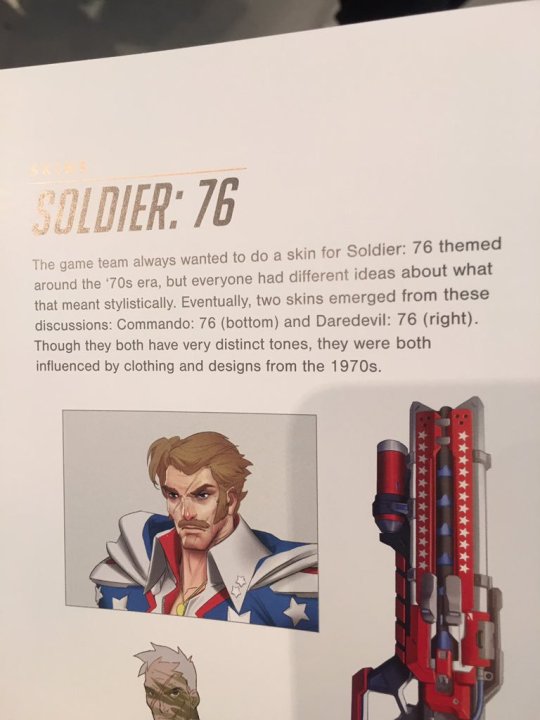
But soon, the Commando skin came to represent something deeper for Soldier: 76 (and Reaper as well).
When the “Uprising” comic was released, there were two panels depicting an aged Strike-Commander Jack describing his experiences in the Omnic Crisis for the first time:

Many people had guessed that the Soldier Enhancement Program was part of a special operations group, but this was the first time this idea was effectively confirmed.
For those of you who may not know, “special operations” are defined as:
Special operations (S.O.) are military operations that are "special" or unconventional and carried out by dedicated special forces and other special operations forces units using unconventional methods and resources. Special operations may be performed independently of or in conjunction with, conventional military operations. The primary goal is to achieve a political or military objective where a conventional force requirement does not exist or might adversely affect the overall strategic outcome. Special operations are usually conducted in a low-profile manner that aims to achieve the advantages of speed, surprise, and violence of action against an unsuspecting target. Special ops are typically carried out with limited numbers of highly trained personnel that are adaptable, self-reliant and able to operate in all environments, and able to use unconventional combat skills and equipment. Special operations are usually implemented through specific, tailored intelligence. (Wikipedia: https://en.wikipedia.org/wiki/Special_operations)
“Commandos” fall under the category of “limited numbers of highly trained personnel that are adaptable, self-reliant and able to operate in all environments, and able to use unconventional combat skills and equipment.”
When the “Uprising” playable event was released in-game, it was quickly discovered that Soldier: 76 had been given a new spray titled “Commando:”

But so had someone else.
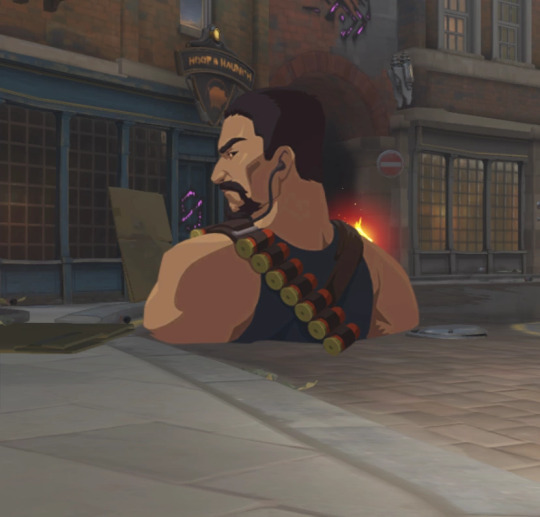
After nearly a full-year since the game’s release in May 2016, Reaper finally received an image depicting him as a “Commando” from the Omnic Crisis Era.
But above all else -
The sprays are meant to be paired together.
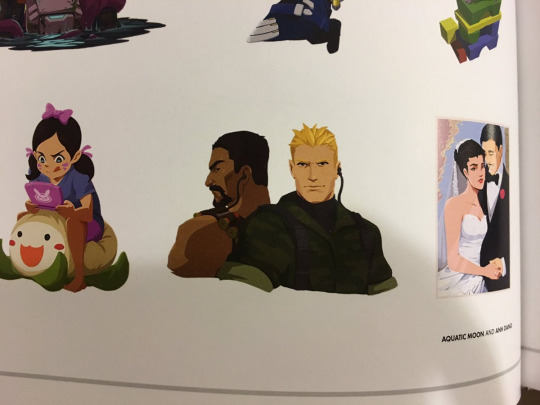
They are a reference to the Contra logo:

...Or you can do the reverse, which makes them, uh -

You can see why people went all out with the “Commander Reyes and I” quote.
Now, with Jeff’s new quote, we have repeated confirmation of what the two characters meant to each other, even from the very beginning:
“The story that we're developing is actually, like–no, these guys loved each other–like–they're like, best war buddies.”
(Sure, Jeff - “best war buddies,” I got ya)
Even from the outset, Gabriel was described as being “a senior officer” to Jack, but that despite differences in their ranks and backgrounds, the two men were friends:
“Overwatch's short list of prospective agents included two members of the soldier enhancement program: Morrison and Gabriel Reyes, a senior officer. Reyes, a hardened and highly respected veteran, grew up about as far from rustic Indiana as you could get—the sprawling urban melting pot of Los Angeles. Despite their differences, the two soldiers became friends.” (source: https://playoverwatch.com/en-us/blog/19809396/)
The Commando sprays - on top of being a cute gaming reference - show their closeness in their early years, when all they had was each other and their special operations squad, in what was an incredibly hostile, incredibly dangerous, incredibly uncertain environment -
Both in the war against robots

And in the “Soldier Enhancement Program.”
Soldier: 24 and Soldier: 76
“The Reaper is an extremely volatile mercenary, a ruthless and remorseless killer responsible for terrorist attacks across the world. He has fought in many armed conflicts in the last decades, showing no loyalty to any cause or organization. Survivors have described a black shadow ghosting unscathed through the most hellish battlefields. The few bodies recovered of those he kills are pale, empty husks drained of life, their cells showing signs of intense degradation. It is possible that he is a byproduct of failed genetic alteration which forces his cells to simultaneously decay and regenerate at a hyper-accelerated rate.” (Reaper’s profile: https://playoverwatch.com/en-us/heroes/reaper/)
“[Moira] was recruited by Gabriel Reyes to be a member of Blackwatch. And uh, during that time she had relationships with the Blackwatch crew - McCree, Genji - they all have their own sort of likes and dislikes for each other. Reyes wanted someone could help advise him on, uh, some matters of genetics that he was, uh, interested in, shall we say.” - Michael Chu, 3:47 (https://youtu.be/HsJU3PEk9JY?t=227)
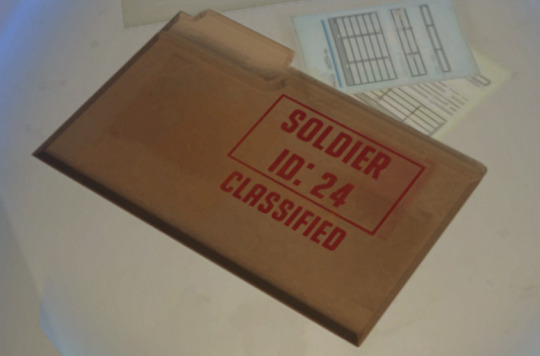
After much speculation about the “decades” line in Reaper’s profile, it appears Blizzard has finally confirmed that - yes - something did happen to Gabriel during SEP.
Something that altered him all the way down to his genetic core.
Fans have been throwing around the idea that “Soldier: 76” is a reference to Jack Morrison’s “Soldier Enhancement Program” number for quite a long time (it’s a personal favorite of mine...which I guess should be obvious at this point, haha), which also led fans to speculate on if Gabriel Reyes ever had a Soldier ID number, and if so, what would it be? People used numbers like “13,” “75,” “666,” etc, but after the reveal of Moira, the Oasis map now has the above folder in her Genetics lab (a spawn room on the University point).
This folder mirrors another one (or rather...two) that can be found in the LumériCo building on the Dorado map:
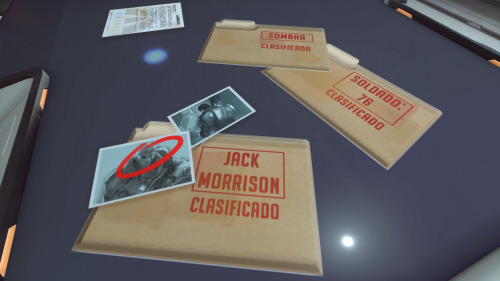
Was Jack aware of the changes in Gabriel’s biology?
The honest answer: we don’t know for sure.
The hopeful answer: yes, he did.
In theory, it would be almost impossible to hide a secret of that magnitude for the nearly thirty years that both men were together. This is coupled with a few other things:
1. Reaper’s description of his “rogue mercenary work” for “decades” appears to fit the definition of clandestine and covert operations to a tee.
Since it’s been confirmed that both men were “commandos” or special operations personnel for the U.S. military, both men knew the skills, tactics, and values of the nature of unconventional warfare, special operations, clandestine and covert operations, and possible “black operations.”
Clandestine and covert operations are military or intelligence operations in which the first one is a secret or concealed operation entirely, and the second one is an operation in which the sponsor or parent organization is concealed.
The United States Department of Defense Dictionary of Military and Associated Terms (Joint Publication JP1-02, dated 5 January 2007) defines "clandestine operation" as "An operation sponsored or conducted by governmental departments or agencies in such a way as to assure secrecy or concealment. A clandestine operation differs from a covert operation in that emphasis is placed on concealment of the operation rather than on concealment of the identity of the sponsor. In special operations, an activity may be both covert and clandestine and may focus equally on operational considerations and intelligence-related activities." (JP 3-05.1). (Wikipedia: https://en.wikipedia.org/wiki/Clandestine_operation)
It makes a ton of sense when put into perspective - by the time of the Omnic Crisis, Gabriel Reyes was likely a young commander in charge of a special operations group or squad on behalf of the U.S. military (I personally see them as part of the Army’s Special Forces (aka “The Green Berets”), but you might prefer a different organization), and either him or his squad was recommended to the “Soldier Enhancement Program,” which likely pooled special operations groups of different ranks, skills, assets, tactics, and potentials to chemically and biologically “enhance” them before sending them out to fight robots. Jack Morrison, while younger, may have had similar skills or was at least in the process of being trained to use or hone them. Most special operations groups are relatively small in terms of the number of people per group or squad - the ground level units of ODAs (Operational Detacthment Alpha squads of the Special Forces) only have 12 people per squad, and each squad can break down into smaller teams of 6 people if the mission requires splitting up or dual-tactics.
The original Overwatch Strike Team only had 5 - 6 people on it (depends on if you think Liao is still a character in development or not).
Gabriel Reyes was the original commander of this group, and may have tailored the group to suit the small-team, clandestine and covert tactics he was used to, or requested that the Strike Team remain small and flexible for unconventional warfare methods in a time when major military operations were failing against Bastions, OR-14s, and Titans the world over. It is not an accident that each member of the original Strike Team appears to also have special operations training, as well as covers major principles of unconventional warfare (e.g. Torbjörn and “combat engineering,” Ana and sniping, Ana and “overwatching,” Jack and combat medicine, Gabriel and “force suppression shotguns,” etc).
Jack Morrison, having also been trained in unconventional warfare and different types of special operations, likely would have understood the need for small, highly skilled, highly specialized teams to conducted clandestine and covert operations, intelligence and reconnaissance missions, and other special operations/unconventional warfare tactics.
In my opinion, it does not make sense that Jack never knew what was going on with Gabriel’s biology, but rather probably worked with him to use it in a way Gabriel was comfortable with and knowledgeable about.
In other words:
2. Gabriel and Jack’s commando backgrounds, along with their early Crisis and OW Strike Team experiences, likely led to the joint decision to form Blackwatch, Overwatch’s covert operations division.
This is likely going to roll into the next part, but effectively, Jack Morrison himself probably created the Blackwatch division, or - with whatever internal Overwatch powers and abilities afforded to him as the new, Post-Crisis Strike-Commander - gave Gabriel the authority to create the Blackwatch division as he saw fit.
Every description of Blackwatch calls it a “division” within Overwatch, meaning that while Gabriel was the division commander (much like how Torbjörn is later described as the “Chief Engineer”), Jack Morrison was the final end in the chain of command.

(Source: McCree’s profile: https://playoverwatch.com/en-us/heroes/mccree/)

(Source: the description for the “Blackwatch Reyes” skin)

(Source: Moira’s profile: https://playoverwatch.com/en-us/heroes/moira/)
And Gabriel’s “Blackwatch Reyes” skin has always had an Overwatch logo on his left shoulder.
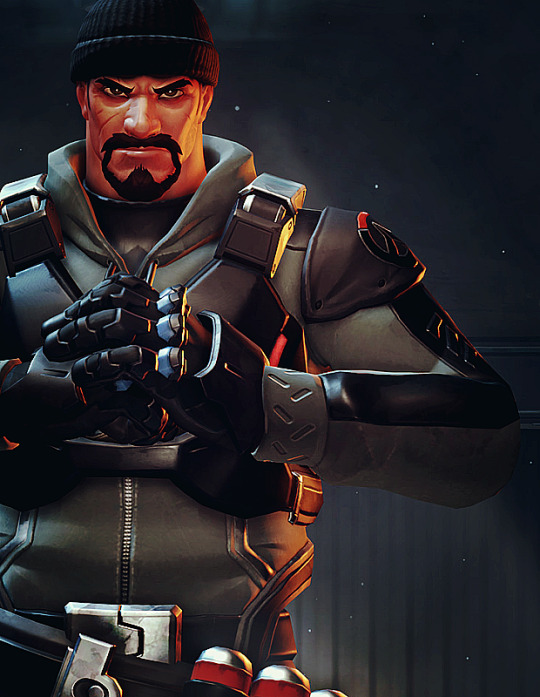
(Which you would think would kinda defeat the purpose of a covert ops division, but all well)

Which brings me to my next point
Overwatch and Blackwatch
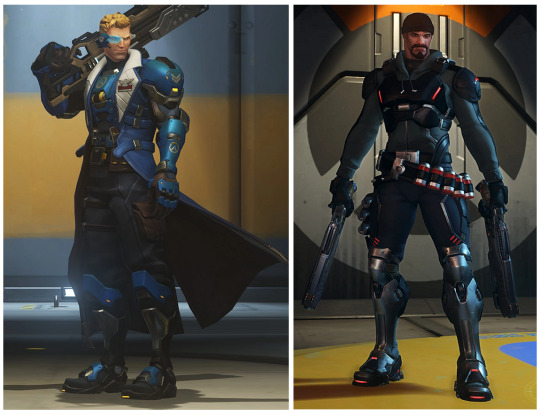
“[...] after they defeated the Omnic Crisis, Morrison was actually given the top position of power and Reyes was overlooked because he was too rogue, he was too maverick in his leadership style–he ruffled too many feathers. And a lot of our fans have assumed "oh, that's why Reyes and Morrison hate each other," and the story that we're developing is actually, like–no, these guys loved each other–like–they're like, best war buddies. And in a lot of ways, Reyes was relieved that Morrison had to have the more political role, and like, he was like kind of–it's always easier being the number two guy because you're not ultimately accountable for all that, Reyes was kind of, you know, in some ways thankful and relieved, um, and weirdly, we're gonna show how that relationship actually was Morrison's downfall because for so long, Morrison would actually defend Reyes's questionable actions. And to us, that feels more like what would actually happen between real people and less just, um, typical cliché black-and-white "this guy is bad, that guy is good," you know, we want to have that depth of relationship because I think it's ultimately more relatable to all of us as kind of human beings.” - Jeff Kaplan in yesterday’s reveal
The greatest part about Jeff’s response yesterday was that it basically confirms all of the above:
Gabriel likely had more experience and more depth of skill in clandestine and covert operations, which did not mesh with the United Nations’ vision of Overwatch moving forward. Sure, during the Omnic Crisis, Overwatch was a special operations and unconventional warfare group specifically designed to infiltrate and destroy Omniums, but after the war was won and the dust of the “near robot apocalypse” settled, the United Nations wanted to expand Overwatch from a single small squad of highly skilled individuals to a much larger organization tasked with enforcing and maintaining peace.
Gabriel probably had very little experience with that, as indicated by Jeff’s line “he was too rogue, he was too maverick in his leadership style–he ruffled too many feathers.” Even if he was and is a skilled tactician and covert ops leader, that does not necessarily translate to public-speaking skills or political maneuvering abilities. Jack Morrison, however, may have performed these attributes better during wartime, interfacing with other military or civilian groups on behalf of Overwatch’s secret missions, as well as potentially interacting with their parent group, the United Nations (and/or the UN Security Council). We know that the Under-Secretary General who helped form Overwatch - Gabrielle Adawe - spoke highly of Jack’s teamwork skills:
"Even I had my doubts about whether Overwatch would succeed," UN Under-Secretary-General Gabrielle Adawe, one of Overwatch's key architects, said shortly after the end of the Omnic Crisis. "But Morrison never gave up hope. He didn't just meet our expectations for what Overwatch and its agents could achieve; he shattered them." (Source: https://playoverwatch.com/en-us/blog/19809396/)
I’ve also seen fans’ speculate that, given Soldier: 76′s biotic field ability, Jack may have been the Strike Team’s original combat medic, or something based on that. Despite being an in-game healer, Ana Amari’s biotic rifle did not develop until much, much later after the Crisis, when Angela Ziegler (Mercy) had joined Overwatch.
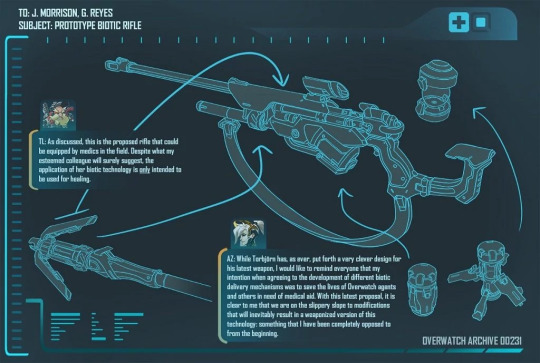
(Notice the two names the blueprint is addressed to, btw.)
In all her “old pictures,” Ana Amari is shown with a few different rifles, but they all appear to be standard sniper rifles.
And all of Soldier: 76′s voicelines about the biotic field are heavily team-focused:
Get over here and heal up!
Anyone need some healing?
Come here and get stabilized.
Field’s down.
Biotic field activated.
Everyone, heal up.
Time to heal up.
Heal up here.
Team, heal up here.
Never leave a teammate behind.
So while Gabriel was the commander, the leader, and the likely tactician of the original Strike Team, the “healer” and “support role” probably fell to Jack. In-game playstyles, though not necessarily canon, would put Jack/Soldier: 76 close to Reinhardt so that Reinhardt could shield his heavy pulse rifle fire, with Gabriel/Reaper operating around their anchor point, as either an offensive flanker against opponents or a defensive protector to help cover them. Ana (assuming she is not healing) and Torbjörn’s turret would help provide suppressive “overwatch” cover, or also cover any holes or gaps in the team’s sides.
It is therefore not unlikely that Gabriel formulated and created the tactics, before giving orders to Jack, who - with the biotic field and his louder voice - was the one that then relayed them to team members or other military groups working with the Overwatch Strike Team.
This partnership has now been confirmed to translate quite well to the Overwatch and Blackwatch operations, with Gabriel’s Blackwatch covert ops division doing reconn, gathering intel, and infiltrating groups (“And in a lot of ways, Reyes was relieved that Morrison had to have the more political role, and like, he was like kind of–it's always easier being the number two guy because you're not ultimately accountable for all that, Reyes was kind of, you know, in some ways thankful and relieved”) -
Before providing that information to Overwatch through Jack Morrison and Ana Amari, who would then use that to implement new Strike Team missions, active U.N. peacekeeping projects, or developing new plans.
When the United Nations or other organizations would ask questions about Blackwatch, Jack “would actually defend Reyes's questionable actions” (again, probably because 1. Jack knew the value of special operations and unconventional warfare and 2. Jack trusted Gabriel to lead those operations as he had always done).
We saw a version of this play out in the “Uprising” comic, which, for the first time, showed a much older Morrison, older Amari, and maybe older Reyes assess a hostile and dangerous situation - the uprising of Null Sector in London.

Notice how Gabriel is snarky and sarcastic with Ana, but when Jack says, “I want to know how Null Sector caught us so off guard,” Gabriel responds with calmer, more factual information. Interestingly, again, it is not Jack who snaps at Gabriel about his use of the word “extremists,” but Ana.
Gabriel follows up with his monologue that, again, is calm and collected, if slightly charged:
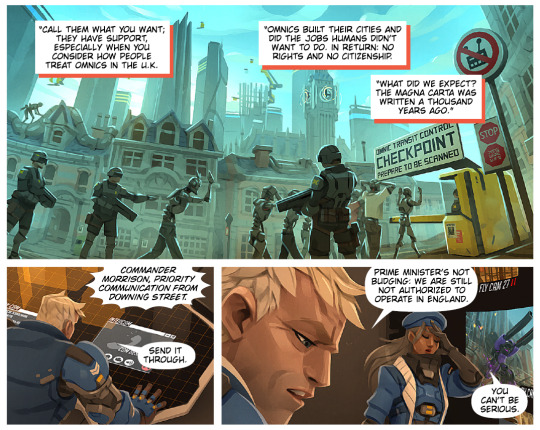
The “Uprising” comic - and then the in-game Uprising event voicelines - were the first time fans had seen “Pre-Talon” Gabriel interact with Jack and Ana (and then later Reinhardt and the rest of the ground-level Strike Team). Through these, we were given a vastly different view of Gabriel than other in-universe material had implied: this version of Gabriel was calm, collected, funny, witty, focused, and almost jovial around Jack, Ana, and Reinhardt.
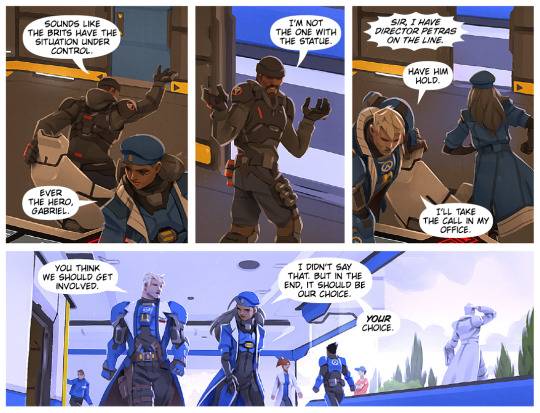
Fans went wild for this version of Gabriel, with a major online movement to get the “Reyes Shrug” as an actual emote, victory pose, or spray in the game, and well -
Blizzard listened
And gave us not one, not even two -
But all three.

(The emote)
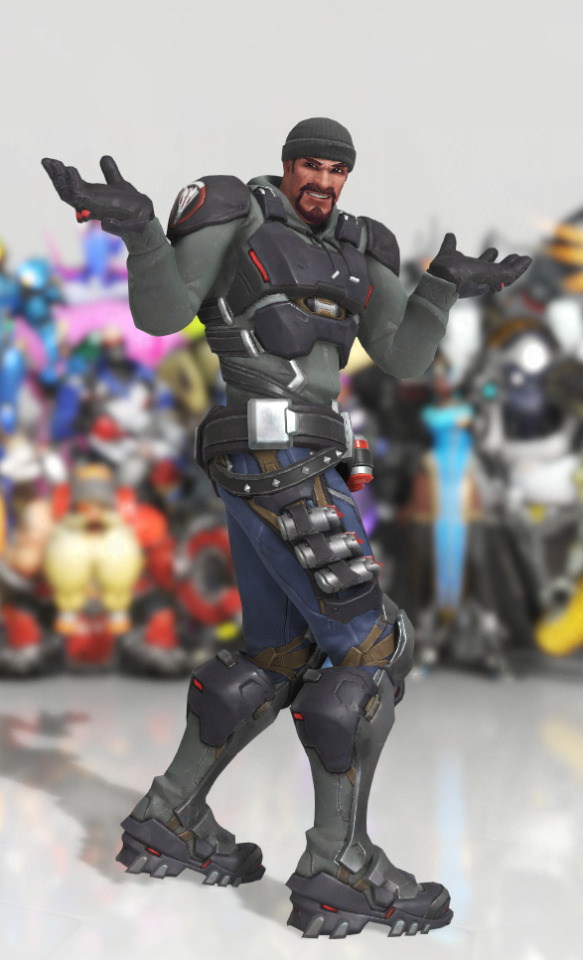
(The victory pose)
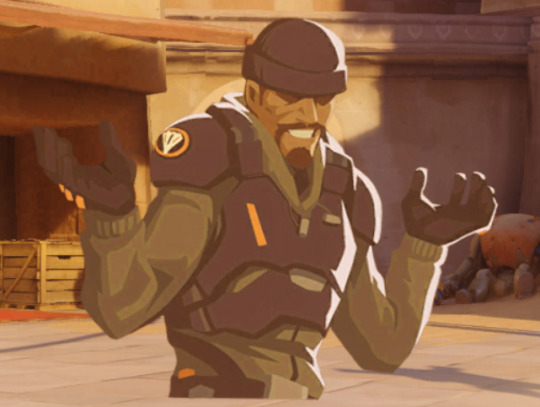
(The spray)
While this happened during the Anniversary event (after the Uprising event), Jack received a very different emote for Uprising.
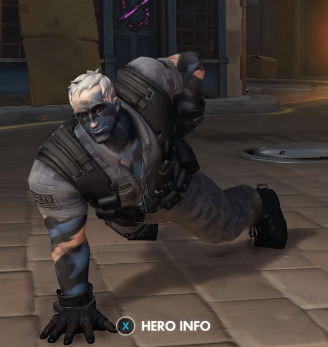
And yeah -
People immediately used it exactly how you’d expect.
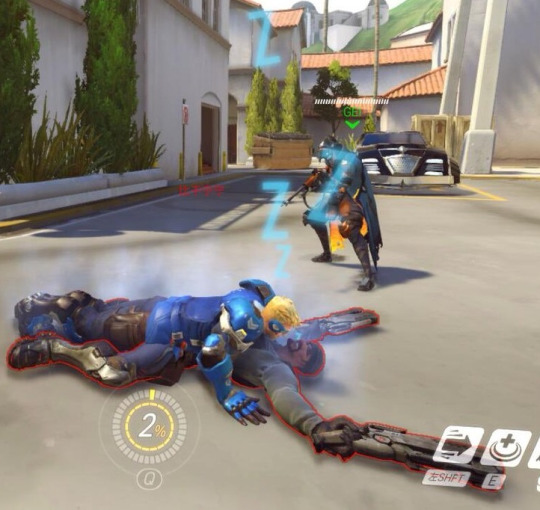
With Uprising, both Gabriel and Jack received voicelines that...had very similar connotations to them, both said fairly dryly/sarcastically:
Reaper: ...Moving on.
Soldier: 76: ...Whatever you say.
And then with the Anniversary event...something else happened with the voicelines that many people didn’t...quite notice.
Anniversary
Jack received the voiceline, “You’re the boss,” which was rather odd, given that he was “the boss” of Overwatch for about 20 years.
However, there is one other time that Jack Morrison uses the word “boss” in canon material.

Given that Gabriel was Jack’s former commander and his “boss,” and that this particular comic panel comes after a major plot point in which Soldier: 76 and Reaper fight each other, it seems rather likely that “You’re the boss” is a voiceline towards Gabriel/Reaper.
Not coincidentally, the word “boss” is used in direct reference to “present day” Reaper by another character:
Sombra: So what are we doing here, boss?
Reaper: I need to pay a visit to a friend.
(We’ll come back to this particular interaction later.)
Meanwhile, Gabriel received the voiceline “No one left behind” which also seemed odd given that Reaper has left Talon grunts “behind” in things like Recall and “Old Soldiers.” It also doesn’t appear to mesh with his “commando” and covert ops background, in which the mission comes above people.
Except that “being left behind” does show up as a line and a concept said by Reaper -
In a very specific context.

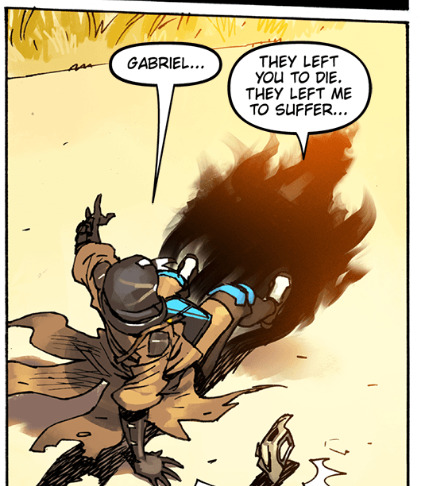
“No one left behind” is incredibly interesting because it gives us a glimpse into Gabriel’s mindset - while his background and skills in covert operations may indicate a non-sentimental, calculating special operations leader, his actual dialogue in several places seems to indicate someone who cares a great deal about his teammates, allies, friends -
And partners.
Which brings us full-circle
To where the end is based on the beginning, and the beginning becomes an end point.
Fall
This is where we get into 100% speculation territory.
For my additional thoughts on this, please see the following:
My version of the Fall of Overwatch timeline: http://segadores-y-soldados.tumblr.com/post/167176447345/and-because-tumblr-is-going-to-destroy-this-post
My discussion on the “death” of Ana Amari and how it affected Gabriel and Jack: http://segadores-y-soldados.tumblr.com/post/159512959195/alright-so-the-subject-of-ana-being-the-source-of
My hypothesis of Overwatch missions and investigations at the time of Uprising: http://segadores-y-soldados.tumblr.com/post/164417776210/devil-in-the-details
My hypothesis that Reaper and Sombra are trying to bring down Talon from the inside: http://segadores-y-soldados.tumblr.com/post/163200042035/death-becomes-you
Now, a lot of this is all theorizing and hypothesizing. It may or may not be true. What I’m going to present here is what we do know, now that we have Moira’s Origins video, and various sources on how Moira and Reaper fit together.
As I brought up earlier, something was likely very wrong with Gabriel’s biology. He’s the only character of the original Strike Team that does not appear to age at all in canon material.
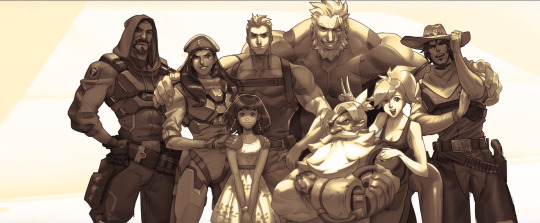
From the early Overwatch days, in which we can see that the “older” team members of Reinhardt and Torbjörn have started aging a bit.
To Uprising

In which Jack and Ana are both shown with greying hair, while Gabriel looks largely unchanged.
(keep in mind there’s likely a gap of approximately 10 years between these two pictures)
To the latest pictures of him from Moira’s Origins video

(An unknown amount of time has progress between Uprising and this moment, or that this moment potentially came before Uprising).
On the subject of Moira’s recruitment, Michael Chu had this to say:
“She was recruited by Gabriel Reyes to be a member of Blackwatch. And uh, during that time she had relationships with the Blackwatch crew - McCree, Genji - they all have their own sort of likes and dislikes for each other. Reyes wanted someone could help advise him on, uh, some matters of genetics that he was, uh, interested in, shall we say.” - Michael Chu, 3:47 (https://youtu.be/HsJU3PEk9JY?t=227)
Which means this tweet now makes a lot of sense:

(Source: https://twitter.com/westofhouse/status/758425704530710528)
Which, again, when we backtrack, we find the “Soldier: 24″ folder in Moira’s lab on Oasis
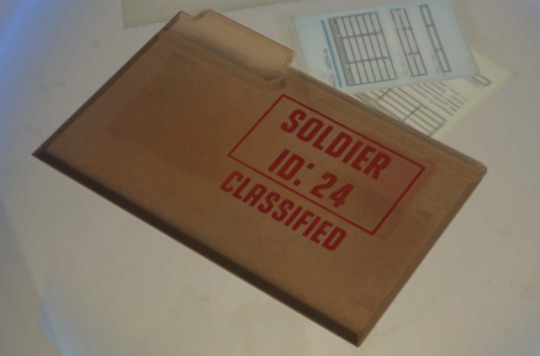
But we also have something else going on:
http://segadores-y-soldados.tumblr.com/post/167135805485/segadores-y-soldados-currently-in-addition
The short version:
Moira is the Minister of Genetics at Oasis. In her lab, you’ll find the “Soldier: 24” folder, along with a copy of Angela/Mercy’s research on the regenerative properties of nanobiology. However, the spawn room on the other side of the map is the Ministery of Chemistry, and in that spawn room, you’ll find this:
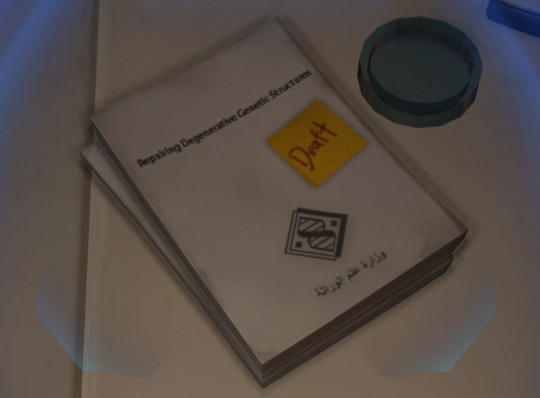
A copy of Moira’s research on “Repairing Degenerative Genetic Structures” with a post-it note that says “Draft” and her Ministry of Genetics lab symbol and name in Arabic.
Which gives us new context to that Sombra-Reaper interaction on Oasis:
Sombra: So what are we doing here, boss?
Reaper: I need to pay a visit to a friend.
And yes, Reaper does appear to mean “friend” in a truly platonic sense of the word because Michael specifically went out of his way to say that Moira and Reaper have only a “professional” relationship between them:
Geoff Goodman: “It [Her Fade ability] has some similarities to Reaper’s wraith form…uh which is…it’s funny how that works out.”
Michael Chu: “You know, we obviously - there’s a…there’s a close relationship between Moira and Reyes-slash-Reaper, and I think one of the fun things we were able to do is to sort of hint at some of those things in her, uh, abilities.”
Geoff Goodman: “She’s helping Reaper out and is like, ‘You know, I think I could make this better, I have an idea.’”
Michael Chu: “Professional relationship.”
Geoff Goodman: “Ahaha, yes…good call.”
Michael Chu: “You know what I’m talking about.”
[Whole panel laughs]
- Time: 14:49 (https://youtu.be/HsJU3PEk9JY?t=889)
(Source: http://segadores-y-soldados.tumblr.com/post/167111711575/moira-preview-new-hero-overwatch-panel)
While I’ve hypothesized here that Jack knew about some (or possibly all) of Gabriel’s conditions, he may or may not have approved of Blackwatch’s decision to recruit Moira. What’s interesting is that Moira’s profile says this:
“Her employment was a closely kept secret, until it was uncovered during inquiries following the Venice incident. Many high-ranking Overwatch officials disavowed all knowledge of her affiliation with them.” (Source: Moira’s profile: https://playoverwatch.com/en-us/heroes/moira/)
But Jeff said this:
“[...] we're gonna show how that relationship actually was Morrison's downfall because for so long, Morrison would actually defend Reyes's questionable actions. And to us, that feels more like what would actually happen between real people and less just, um, typical cliché black-and-white "this guy is bad, that guy is good," you know, we want to have that depth of relationship because I think it's ultimately more relatable to all of us as kind of human beings.”
It’s difficult to parse out, and while I have my own theories and ideas, the answer is not yet discernible. Did Jack know about Moira’s recruitment? Did he approve of it? Did he defend her position publically? Did he not know but defend Blackwatch anyways?
Did he request that Gabriel seek her out?
We don’t know yet, but I welcome all possible theories. It adds significantly more depth to the later years of the relationship between Gabriel and Jack, and complicates things significantly. We need to remember that, according to his own words, Reaper blames Jack for “leaving [him] to suffer” and “become this thing.”
This concept is at a disconnect with the likelihood that Moira either worsened his genetic condition and therefore hastened his shift into “Reaper,” or that she “unlocked [his] potential” and forced the “state of existence” on him entirely.
Or that she was truly, genuinely trying to help.
Remember - Moira’s Origin video is told from her perspective. Michael Chu said this:
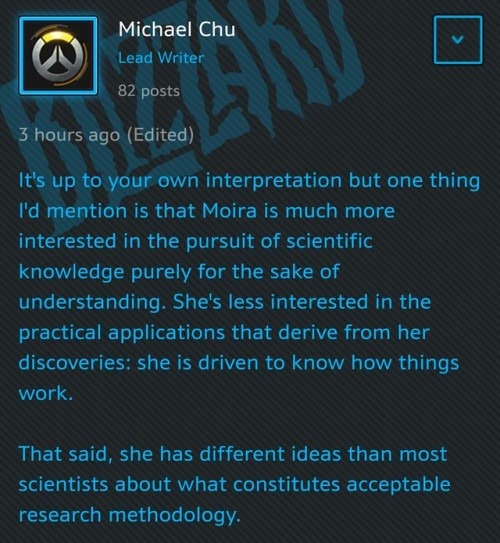
(Source: https://us.battle.net/forums/en/overwatch/topic/20759241192#post-13)
In her own mind, it’s possible that Moira genuinely believed she was helping Gabriel “improve” by whatever her research or experiments on him did to him (or whatever they found out).
However, we also know that Nesskain, the artist behind Moira’s Origins video, had this to say about Gabriel’s feelings:

(Source: https://twitter.com/nesskain/status/926674887615188992)
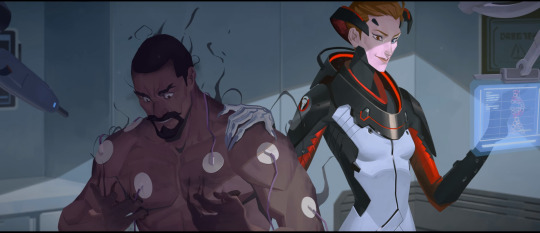
(Tumblr link: http://segadores-y-soldados.tumblr.com/post/167110576805/httpstwittercomnesskainstatus926674887615188)
Between this, Reaper’s “He did this to me, Ana” line, and the supposed “battle” at the Swiss Watchpoint, something major occurred, and it could be any number of possibilities - a genuine falling out between two old soldiers and “war buddies,” a heartbreaking schism between two men who “loved each other,” an inevitable split between partners whose visions for the world had shifted from each other, or, hell, even a “fake” fight in order to preserve an infiltration mission.
Pick your card and play it.
Personally, I see it as some sort of combination of events, but without more information, it’s pretty much impossible to say for certain. There are, however, some suspicious details lingering elsewhere.
The City of the Dead, and the Shadows that connect people
Unless you play Elimination or the Death Matches, you might never come across the Necropolis and Castillo maps, but man, I would urge everyone who enjoys the characters and wordbuilding of Overwatch to set up a custom game and just wander around because these are full of details.
First up:
Necropolis
The Necropolis is Ana Amari and Soldier: 76′s current hideout on the outskirts of the Giza Pyramid complex. This allows Ana to continue her current personal mission of safeguarding the Temple of Anubis (as well as keep an eye on her daughter’s Helix squad), and also gives her a safe place to store her biotic grenades and darts equipment.
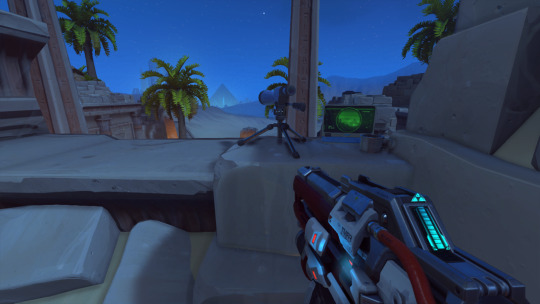
Ana’s look out over the Temple of Anubis
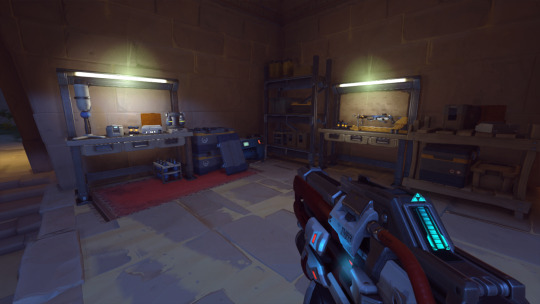
Ana’s workshop

Jack’s...uh...corner.
But the truly interesting part is this:

The “Reaper sightings” computers.

Here’s the map. The locations are:
Volskaya Industries, St. Petersburg, Russia (the “Infiltration” short)
Watchpoint: Gibraltar, Gibraltar (the “Recall” short)
Numbani, Nigeria (the museum heist trailer)
Oasis, Iraq (confirmed now that Moira is there)
And perhaps the most and least surprising of all:
Los Angeles, California
Gabriel’s original home.
Now -
When did “Reaper” go home?
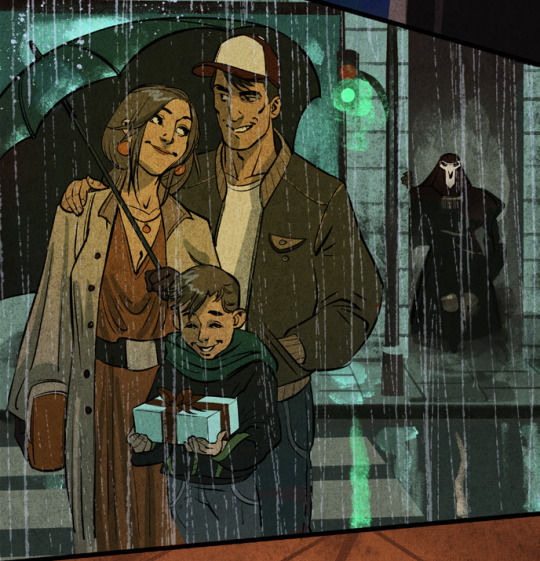
(Yeah, yeah, and contrary to popular belief it does rain in California sometimes, okay?)
Lots of speculation has occurred around this panel - who exactly are these people? Are they related to Gabriel? Are they old friends? Is one of the adults an ex-agent of Overwatch?
Keep in mind that even if he hasn’t aged, Gabriel is chronologically in his early to mid-fifties in the present day. Overwatch’s playable and background characters tend to have really...vague ages, but personally, I see this family as being related to Gabriel, possibly as a sibling or an adult niece or nephew. I have seen some people speculate one of the adults could be his child.
What I find more interesting, however, is the question:
How did Jack and Ana get this information that Reaper visited Los Angeles?
Castillo - Sombra’s Room
Sombra’s room is a treasure trove of implied connections and details. Something that’s important to keep in mind is that Sombra is one of the few people to know canonically that Gabriel is Reaper.
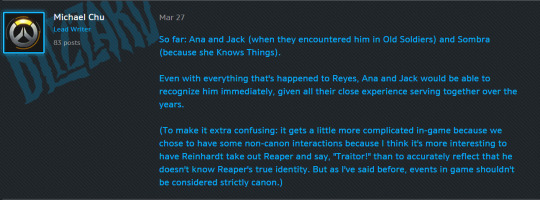
(Source: https://us.battle.net/forums/en/overwatch/topic/20753735625#post-13)
Now, this was posted before Doomfist and Moira were revealed, so we don’t know the status of them (Moira seems like a “no duh” answer, but honestly, considering how Michael said that neither McCree nor Reinhardt know, I’m skeptical about how much Doomfist knows), but effectively, Sombra “knows the truth about Reaper.”
Which means this interaction is canon:
Sombra: What's the plan today, Gabe? You don't mind if I call you Gabe, do you?
Reaper: Stick to the mission.
What is Sombra referencing?
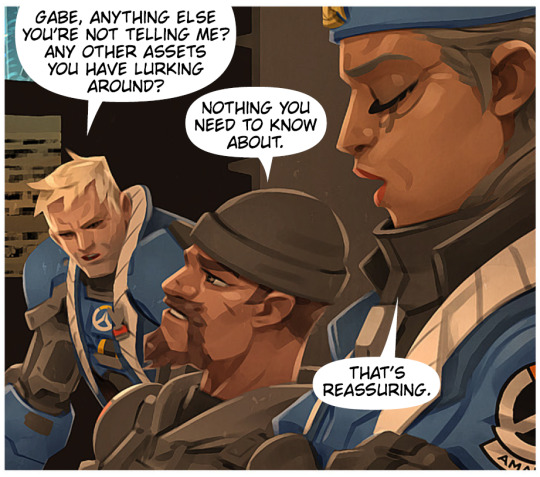
The only other person to use the nickname “Gabe” for Gabriel -
is Jack Morrison.
In her interactions with him, Ana calls him “Gabriel,” as does her daughter Fareeha when she references. McCree never addresses him by name, but considering that Gabriel uses the line “Reyes here” during the in-game Uprising event, he apparently prefers to stick with surnames during operations.
But that goes out the window with Jack.
And Sombra absolutely knows this.
Because in Sombra’s room, you can find these:
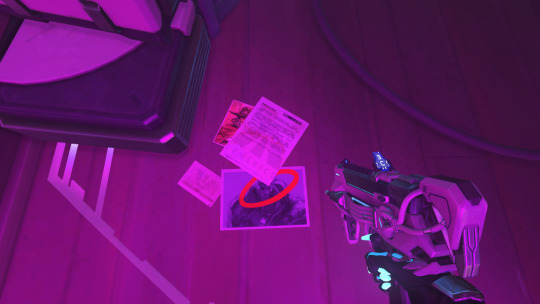
A picture of Jack Morrison and Jesse McCree.
Sombra also apparently knows about Ana because:
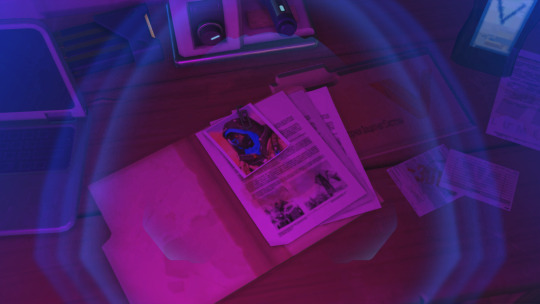
She has a file on Ana’s “Shrike” bounty hunter identity
As well as this interesting little tidbit:

Which shows Ana’s face.
The McCree stuff is also interesting because Sombra and McCree may have had contact with each other at about the same time that Gabriel is visiting Los Angeles:

Does Sombra have contact with Jack and Ana?
Again, the honest answer is: we don’t know.
But the hopeful answer is: possibly.
In the more recent “Searching” comic, Lynx-17, a hacker who has been trying to track Sombra’s efforts, said this:

And somehow -
Sombra has some sort of connection to Soldier: 76.
Sombra and Soldier: 76 are also the only two characters heavily invested in uncovering LumériCo’s shady dealings. Sombra, of course, had her massive ARG, in which LumériCo’s corruption was slowly (very...very...slowly) revealed by players. Soldier: 76 is the only other character to express interest in LumériCo, with the line:
“I wanna know what LumériCo's been up to.”
However, we also know he’s anti-Los Muertos, the arms-dealing gang that supported Sombra’s efforts against LumériCo.
Do Sombra and Soldier: 76 have a tentative alliance? Are they sharing information? Is she helping him track Reaper? Sombra was not present when Gabriel went home to Los Angeles, but she is present in the Volskaya Industries infiltration mission and Reaper’s “visit” to Oasis. Interestingly, the pictures on the blue screen of the “Reaper sightings” computer are from the Volskaya Industries mission...and Sombra was the one running the cameras.
Again - how deliberate is all this?
You know the drill by know:
Honest answer: we don’t know.
Hopeful answer: Hopefully deliberate.
Lastly, because this section is getting kinda long -
Reaper and Sombra share one final interaction that is very...interesting to think over:
Reaper: Try to stick to the plan, Sombra.
Sombra: Look, someone has to be ready when all your careful planning doesn't pan out.
Again, does it mean anything? Who knows. But bear in mind that Sombra is one of the few people to know that Gabriel is Reaper, and that Gabriel has always been the commander trained in stealth, covert operations, reconn and intelligence gathering, and infiltration missions. Sombra knows this, and Gabriel knows she knows it too. They appear to have a tentative trust with one another, and again, Sombra is the only person (besides Jack) to have ever called Gabriel “Gabe” and “boss” (at least, that we know of). Gabriel was also aware of her “plan” to throw their Volskaya mission, which means he not only let Sombra deliberately trigger the alarm system, he also willingly let Katya Volskaya escape.

(Source: Masquerade comic)
“But if Reaper is working with Sombra, why would he tattle on her?”
Again, honest answer, hopeful answer, blah blah blah. You’re not here for me to say “I don’t know 100 times,” you’re here for the hopeful answer.
The hopeful answer is that:
Again, Gabriel has experience with infiltration and intel missions - he’s been doing this for thirty years, possibly longer given his military experience. There is almost no faster way to gain one person’s trust than to “snitch” on another, to show that you’re going to work with Person A instead of Person B. It’s a risky move, but if Person B is willing to pretend to be the “fall guy,” they then can try to cover each other better. Which again -
Goes back to who has the “back up” ideas when all of Reaper’s “careful planning doesn’t pan out”?
At the Blizzard voice actors panel at Anime Expo 2017, Michael Chu said this:
“Yeah, you know, [Sombra] gets on [Reaper’s] nerves a little bit, but I think that, ultimately, Reaper knows that Sombra is...effective, and so he respects that because he is a good eye for talent. (Audience starts to cheer) Look at that Blackwatch team - it’s amazing!” - Michael Chu (Timestamp: 45:48 https://youtu.be/JPQi61a8fD0?t=2748)
Now -
What is Sombra effective for?
Finding secrets that are hidden.
Sombra has found LumériCo’s shading dealings. She’s found connections between LumériCo and Vishkar and Volskaya. She’s found where Katya is getting her new mech technology from (a group in Numbani).
(And Reaper may not know these ones but) she has found that Ana Amari is alive. She has found connections between Ana Amari and Jesse McCree.
She is investigating Jack Morrison -
And has a connection to Soldier: 76 somehow.
And more than anything else
Sombra knows Gabriel’s nickname is “Gabe”
And she knows who used to call him that.
And she very likely knows Jack’s end of this as well.
What does Soldier: 76 want more than anything else?
To find out who brought down Overwatch.
---
So now we’ve essentially caught up with the current plot. Reaper and Sombra are running around working with Doomfist and Moira. Soldier: 76 and Ana are hiding out in the Necropolis. Winston has initiated Recall and so far, Tracer, Genji, Reinhardt, and Mei are answering it and returning to Overwatch. Doomfist has partially destroyed Numbani and reclaimed his Gauntlet. Efi Oladele has built Orisa. Sombra has managed to persuade Zarya that Katya Volskaya is not to be trusted. Junkrat and Roadhog are trying to trick the Queen of Junkertown to let them back in. Torbjörn is working with Bastion on something (???). Moira is conducting research in Oasis (and may be fighting the Ministry of Chemistry to get her research back).
Where do we go from here?
There are a few avenues:
1. We will likely see more characters answer the Recall initiation and return to Overwatch. Who - we don’t know yet. Mercy, Torbjörn, and McCree are all still potential returnees.
2. We will start seeing Talon become more emboldened about moving forward with their plans to accelerate the Second Omnic Crisis - now that Doomfist is out of prison and Vialli (who was more content with easy profits in peace) is dead, Doomfist appears to be taking more control over the council that runs the organization.
3. We will likely see Soldier: 76 and Ana react to these, especially if they are tracking Reaper or are being given information on his locations from an “inside source” (like Sombra or even possibly Reaper himself). We know that the two of them are trying to prevent Anubis from breaking out of his confinement...and possibly prevent others from breaking in to help him, and they are in the next-closest playable location to Oasis.
4. We will start seeing repercussions for Winston’s Recall, as Overwatch is still illegal and formally disbanded. The United Nations, along with its contracted military support service, Helix Securities, may start making strong moves to stop Winston and the new Overwatch group, or may go after old members who are conspiring to bring it back.
5. I personally suspect we will start seeing more of Vishkar, and as a related connection to them, Lúcio. Sanjay Korpal - Satya Vaswani’s (Symmetra’s) boss - has shown up in Talon meetings twice now (once in the Masquerade comic and again in Moira’s Origins video). Lúcio managed to increase public awareness against Vishkar’s unethical and immoral actions in Rio de Janeiro, and he’s a major popular folk hero and inspiration the world over.
6. I also suspect we will eventually see the return of Null Sector in some way, shape, or form. Although Mondatta is dead, there are the implications that anger and bitterness still linger among Omnics in London, and both Doomfist and Moira have lines that imply that Talon is looking to ignite that anger into something larger. A large portion of the Overwatch-affiliated cast, such as Reinhardt, Tracer, Torbjörn, Mercy, Soldier: 76, Reaper, Ana, and McCree, all made large efforts to stop Null Sector seven years ago, and while Reaper is working for Talon, and Soldier: 76, Ana, and McCree have all gone rogue, I doubt any of them want to see Null Sector return again.
7. We hopefully will see Orisa’s clash with Doomfist. Numbani is something like Doomfist’s old stomping grounds, but now that Efi has built Orisa, there’s someone there who is uniquely designed to counter Doomfist in many ways. As an aside, if she’s still alive, Gabrielle Adawe - one of the founders of Overwatch - may also live in Numbani, and could return to the plot somehow.
8. In his most recent AMA with the Overwatch subreddit, Jeff alluded to the fact that background characters like Maximilien, the Queen of Junkertown, Lynx-17, and Hammond (the rogue “specimen” from the Horizon Lunar Colony) may all eventually become playable (source: https://www.reddit.com/r/Overwatch/comments/7bdyby/blizzcon_2017_interview_jeff_kaplan_bill_warnecke/). Hammond in particular provides an opportunity to both explore Winston’s backstory as well as motivate Winston to use Recalled Overwatch in a bolder manner going forward. Lucheng links Lijiang Tower (where they have a base of operations) and the Horizon Lunar Colony together, and it’s very likely that Hammond has a major grudge to settle with them for their illegal and unethical treatment of great apes in the moon colony.
And the one you’re actually reading this longass post for:
9. Gabriel and Jack begin the process of reconciliation.
Yes, it’s “hopeful,” perhaps blindingly so, but isn’t that the whole point of Overwatch? Isn’t that what the game is about? ...Okay, ignore the part where two teams of six people go and shoot each other in Hollywood backlots - once you get past that part, isn’t Overwatch about hope? About heroes? About how anyone and everyone can be a hero in their own right?
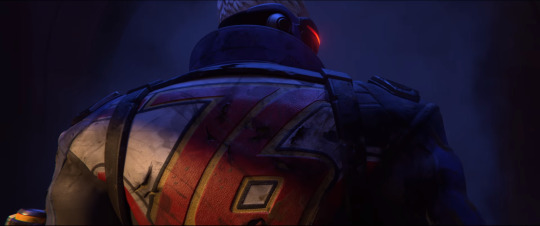
And doesn’t every “hero” need a “villain”?
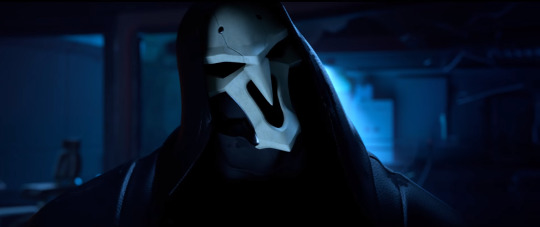
(even if he is pretty frustrated with his...rather incompetent lackeys.)
After all -
this is a song and dance they’ve done for nearly thirty years.
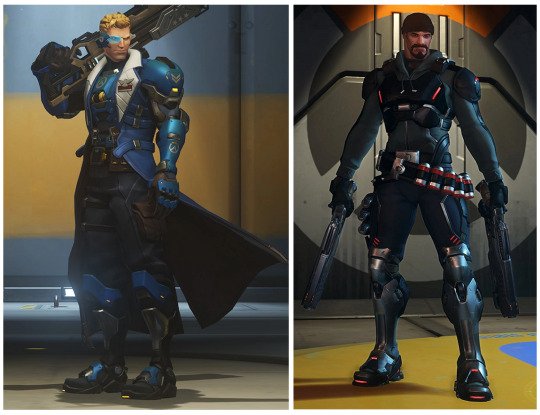
Soldier: 76: Well. You sure take to this “bad guy thing” easily, don't ya?
Reaper: And you sure know how to play “boy scout.”
According to Michael Chu’s 2017 GDC talk “Thinking Globally: Building the Optimistic Future of Overwatch”:
“What’s important to us is that [the villains’] motivations are not purely rooted in being evil, despite how they might seem on the surface. As we reveal more about these characters, we want people to be able to empathize and understand their beliefs. Because sometimes what makes a villain a villain is the extent to which they’re willing to go to reach their goals. And one thing that we find most important when we’re talking about our villain characters is that there is nothing to say that a villain cannot be as charismatic or more charismatic or as likeable as a hero character - because, like the old saying goes, ‘every villain is the hero of their own story.’”
And what better way to get someone to trust you -


Than to “sell out” a longtime ally and partner to further the goals of your “new organization”
And play the part of the “villain?”
But who is going to be there to cover his back and defend his actions this time?
Soldier: 76: One of these days someone is gonna to put an end to you.
Reaper: I invite them to try.
Sombra, the hacker with her own agenda? Widowmaker, the sniper who feels alive only when she kills? Moira, the one who possibly made him this way?
Or perhaps him -
His “best war buddy”
The one who loved him back -
Who calls himself by a number that only Gabe will recognize the full history and “depth of relationship” behind.
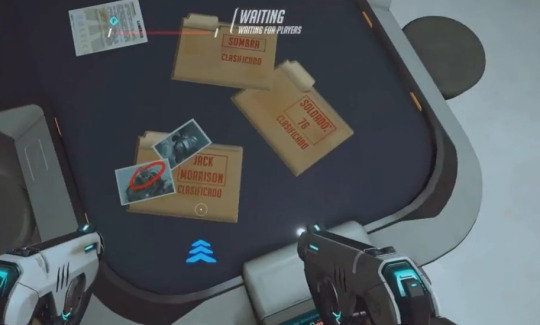

And the last one:
10. I think we will eventually see what Gabriel’s actual “careful planning” is.
Whether that’s bringing Talon down or stopping Recalled Overwatch, we don’t know yet -
But you know the drill by now.
There’s the honest answer
and the hopeful one.
And you can guess which one I’m willing to place my bets on.
#reaper76#r76#reaper#gabriel reyes#soldier 76#jack morrison#my essays#overwatch lore#overwatch theories#overwatch ideas#GOD THIS FELT SO GOOD TO WRITE#resources#references#reaper references#soldier 76 references#talon#team talon#ana amari#moira#moira o'deorain#sombra#long post
942 notes
·
View notes